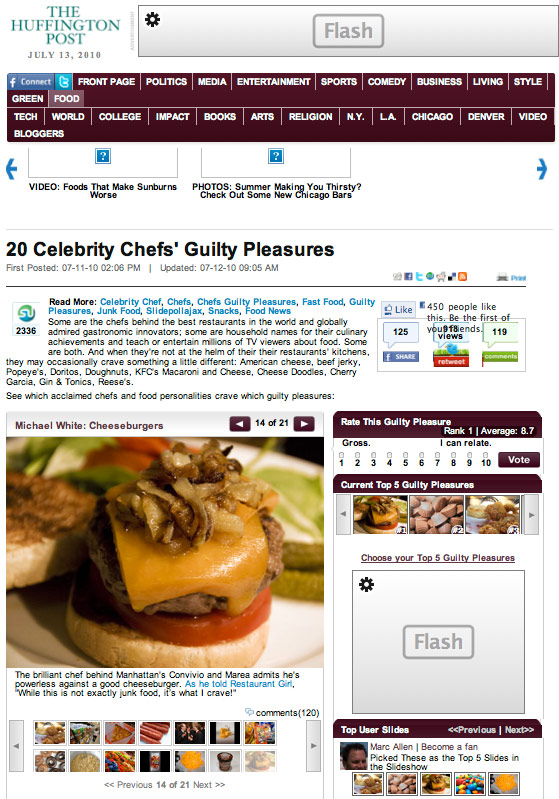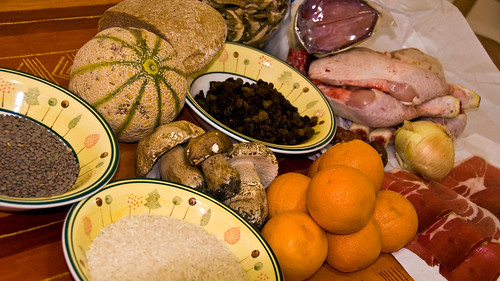It's a popular sign throughout Paris during the summer. "Closed for remodeling."
Summer officially ended yesterday, meaning that anyone who still has this sign up is covering up the fact that they've gone under... or is enduring typical construction/administrative/plumber-not-fucking-showing-up delays endemic to doing business here.
The good news for loyal readers is that we have not gone under. In fact, we've got a backlog of delicious, dirty, and even degenerate fun to post about.
The bad news is that we were actually on vacation, goofing off, having fun, and generally slacking on the site redesign. So those of you who were about ready to delete this idle site from your RSS feeds or Google Reader or whatnot... DON'T!
We'll be back. Bigger. Badder. And more food porny.
21 September 2010
26 July 2010
Just the Tip
Over the weekend, a friend of ours invited us and another couple to his place in northern France. We don't get out of Paris nearly enough, so we jumped at the opportunity to be somewhere with wide open space, tons of greenery, and – hell to the yes – a barbecue grill. I'd promised the Gallic crew some real California barbecue, and we were poised to stuff their mouths with a huge portion of West Coast meat.
NOTE: That sound you just heard was half the population of Texas, Tennessee, Missouri, and the Carolinas collapsing at the thought of left coast "BBQ." And, yes, if you have a Dick Cheney-sized stick up your Texan ass, what we do in California isn't barbecue but "grilling," but to-may-to, to-mah-to, it's still freakin' barbecue as far as we're concerned. What y'all do is "smoking."
Backyard barbecue in France – from what we understand, living in a city that's got tight restriction on grills and very few back yards – is usually limited to grilling merguez and chipolata sausages that are then thrown into a baguette sliced like a Subway sandwich. On the other side of the token, if you get anything "barbecue" in a restaurant, it's usually just whatever meat slathered in something masquerading as "barbecue sauce." The only exception we've found was when we were treated to a massive post-wedding-day grilling of lamb over wood coals near Toulouse. That said, doing "grillades au feu de bois" is not uncommon (though it's almost certainly never marinated or rubbed), but it doesn't seem to ingrain the same ritual or mythical status that a barbecue does in the US. Standing around the fire, swigging beers, poking at the coals... You know, man stuff.
So back to importing California to France... No one knows what the hell a tri-tip is in France. In fact, very few people know what a tri-tip is beyond the West Coast of the US. This triangular cut of bottom sirloin was once dirt cheap (I used to buy entire 3-4 lb. tri-tips for $3-4 when I was in college) but due to increasing popularity has risen stratospherically in price. Especially because there are only two pieces per beast. Some French know this, and thus it's called the "aiguillette baronne" (the baron's tip) whose noble name screams "expensive and rarely ordered." Luckily we have a very good butcher who knew exactly what we were talking about when we placed an advance order for the cut... at €30/kilo.
An entire tri-tip (which, unless you insist upon cutting it into steaks, is the only way to go) typically weights 1.5 to 2 kilos. Our butcher's Salers cow, a breed of longhorn from the Cantal region of France, yielded a 1.5'er that, unfortunately, went down to 1.39 kilos after he kindly trimmed off the fat. I was a bit alarmed by this, as I normally prefer to leave the layer of fat on top as I grill a tri-tip to seal in moisture, but as it often goes with Salers beef, it's one moist, juicy piece of cattle. In fact, Salers is the only European breed that even when grass-fed produces beautifully marbleized flesh.)
As for the preparation of the meat, a proper Santa Maria tri-tip (where this form of BBQ originated), requires nothing more than a healthy rub of salt, pepper, and garlic powder. The magic of Santa Maria tri-tip comes from the wood smoke penetrating the meat to give it a distinct flavor. The trouble is I knew we'd only have access to "regular" charcoal. So we opted to go the other way, the marinated tri-tip.
There's no rule for marinating a tri-tip other than your own. Mine is to marinate overnight, lest the marinade contain a very softening agent like papaya, in which case I wouldn't marinate for more than a couple of hours unless you like your meat turn to mush in your mouth. Otherwise, you can do what you want with it. We went with a "standard" marinade of soy sauce, sugar, garlic, lemon juice and booze and let it rest in the fridge overnight.
But you know us, we can't leave well-enough alone. I got up early before we had to catch our morning train from Gare du Nord and drained every drop out of my meat. Then I took the tri-tip out of the marinade. After patting it dry, I rubbed it in ground Penja black pepper and dried elephant garlic I'd grated in a pestle and mortar. No need for salt - the bad boy had already soaked up the soy. "What are you doing?" Alannah asked. "Doubling up," I told her. The objective was to have the marinade for flavor, but to have a nice Santa Maria-style crust.
Come grilling time – 15 minutes on either side for medium, followed by 10 minutes to "rest" before slicing – the marinated-then-dry-rubbed bastard tri-tip looked perfect. And the gustatory result? Well, let's just say we've got some converts who'll be begging for more California meat in their mouths in the near future. In fact, one of the guys is ready to talk to his butcher aboutaiguillette baronne tri-tip for the rest of his cookouts this summer.
One thing we've still got to work on, though, is ritual. The sun hid behind the clouds so we immediately took refuge inside, sipping cocktails and then eating the tri-tip off of proper serving plates with cutlery and vegetables on the side. As veteran San Francisco barbecuers, we can say as charming as this all is, the whole attraction of barbecue is gathering around to the pit/kettle/flame, drinking cold ones, poking at the coals... rain/fog/windchill or shine.
We've got our work cut out for us.
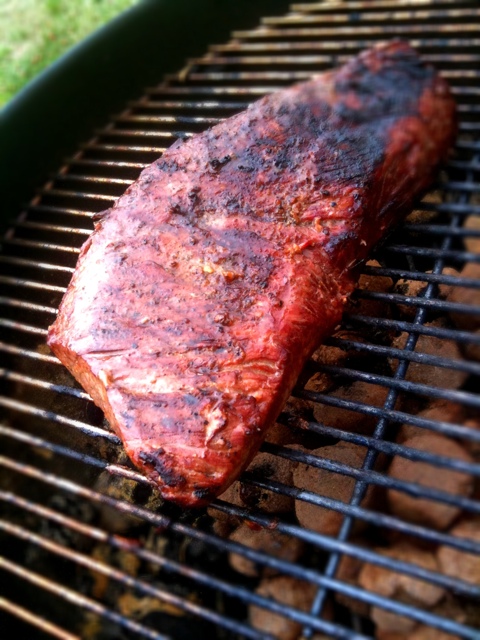 |
| Extra-amateur food porn. We only had the iPhone camera for the pix this time around. d'OH! |
Backyard barbecue in France – from what we understand, living in a city that's got tight restriction on grills and very few back yards – is usually limited to grilling merguez and chipolata sausages that are then thrown into a baguette sliced like a Subway sandwich. On the other side of the token, if you get anything "barbecue" in a restaurant, it's usually just whatever meat slathered in something masquerading as "barbecue sauce." The only exception we've found was when we were treated to a massive post-wedding-day grilling of lamb over wood coals near Toulouse. That said, doing "grillades au feu de bois" is not uncommon (though it's almost certainly never marinated or rubbed), but it doesn't seem to ingrain the same ritual or mythical status that a barbecue does in the US. Standing around the fire, swigging beers, poking at the coals... You know, man stuff.
So back to importing California to France... No one knows what the hell a tri-tip is in France. In fact, very few people know what a tri-tip is beyond the West Coast of the US. This triangular cut of bottom sirloin was once dirt cheap (I used to buy entire 3-4 lb. tri-tips for $3-4 when I was in college) but due to increasing popularity has risen stratospherically in price. Especially because there are only two pieces per beast. Some French know this, and thus it's called the "aiguillette baronne" (the baron's tip) whose noble name screams "expensive and rarely ordered." Luckily we have a very good butcher who knew exactly what we were talking about when we placed an advance order for the cut... at €30/kilo.
An entire tri-tip (which, unless you insist upon cutting it into steaks, is the only way to go) typically weights 1.5 to 2 kilos. Our butcher's Salers cow, a breed of longhorn from the Cantal region of France, yielded a 1.5'er that, unfortunately, went down to 1.39 kilos after he kindly trimmed off the fat. I was a bit alarmed by this, as I normally prefer to leave the layer of fat on top as I grill a tri-tip to seal in moisture, but as it often goes with Salers beef, it's one moist, juicy piece of cattle. In fact, Salers is the only European breed that even when grass-fed produces beautifully marbleized flesh.)
As for the preparation of the meat, a proper Santa Maria tri-tip (where this form of BBQ originated), requires nothing more than a healthy rub of salt, pepper, and garlic powder. The magic of Santa Maria tri-tip comes from the wood smoke penetrating the meat to give it a distinct flavor. The trouble is I knew we'd only have access to "regular" charcoal. So we opted to go the other way, the marinated tri-tip.
There's no rule for marinating a tri-tip other than your own. Mine is to marinate overnight, lest the marinade contain a very softening agent like papaya, in which case I wouldn't marinate for more than a couple of hours unless you like your meat turn to mush in your mouth. Otherwise, you can do what you want with it. We went with a "standard" marinade of soy sauce, sugar, garlic, lemon juice and booze and let it rest in the fridge overnight.
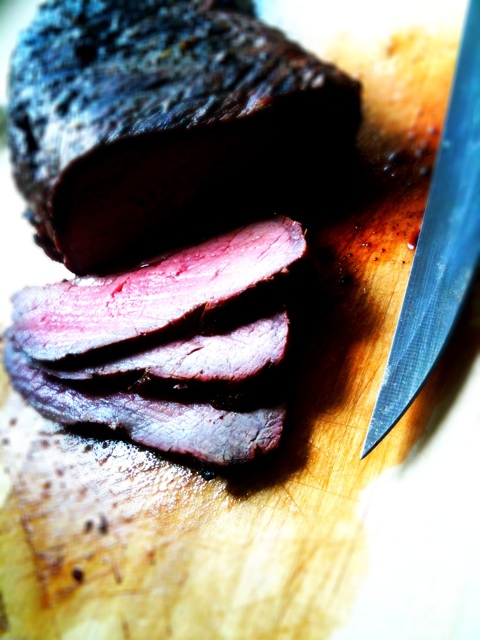 |
| Stupid iPhone 3GS camera... at least it picked up on the lovely pink flesh. |
Come grilling time – 15 minutes on either side for medium, followed by 10 minutes to "rest" before slicing – the marinated-then-dry-rubbed bastard tri-tip looked perfect. And the gustatory result? Well, let's just say we've got some converts who'll be begging for more California meat in their mouths in the near future. In fact, one of the guys is ready to talk to his butcher about
One thing we've still got to work on, though, is ritual. The sun hid behind the clouds so we immediately took refuge inside, sipping cocktails and then eating the tri-tip off of proper serving plates with cutlery and vegetables on the side. As veteran San Francisco barbecuers, we can say as charming as this all is, the whole attraction of barbecue is gathering around to the pit/kettle/flame, drinking cold ones, poking at the coals... rain/fog/windchill or shine.
We've got our work cut out for us.
23 July 2010
It's It! Sweetly Sandwiched San Francicso Style
Alannah and I recently set out on a mission: To represent San Francisco in Paris. The reason is two-fold.
First, as San Franciscan transplants with an inferiority complex, we're sick and tired of anything remotely American here being described as "New Yorkais." Local writers have recently described a chef from Chicago, a coffeehouse owner from Washington and freakin' burritos as New Yorkais. Dubya. Tee. Eff.
Secondly, we don't really know of many people reppin' the Bay. There's Andy at our local favorite sushi joint Rice and Fish who's doing it right, and there's... uh... wasn't Alice Waters supposed to open a restaurant next to the Louvre some time back? Then you've got your French folk like Loic Le Meur (Seesmic, Sarkozy spokes-ass) and Benjamin Tremoulet (H.A.N.D.) who spent - judging by their products - about four hours in California and decided to build their businesses around their (in)experience and trust funds.
So we've got some projects in the hopper, hoping to bring real streetfighter SF culture to the old-school dining mecca. We talk a lot of shit, but we also put our money where our mouths are. And right now we're finding a lot more shit than places we want to put our mouths.
In the meantime, if we wanna make a wave, we've gotta work on desserts! And we're starting by perfecting a premium, locally-sourced-as-possible version of It's-It ice cream sandwiches, also known as "A San Francisco Experience since 1928." Basically, it's one scoop of ice cream, two oatmeal cookies, and dark chocolate.
Alannah's quite good with dessert. Especially baking. She's gone sans oven for the last torturous month (which is about how long it takes a landlord to replace a faulty appliance 'round here...) and she's finally back in action. The "cowboy cookies" she's been making since childhood will serve as the bread in this dessert sammy.
I, on the other hand, blow fucking donkey dicks when it comes to baked goods and confectionery.
This wasn't the case nearly two decades ago. As a young punk, I used to sling out cakes and ice creams to Bay Area yuppies like it was going out of style. I'd spend a good chunk of my summer days inside a walk-in freezer, sculpting melty sugary materials that'd otherwise disintegrate in the ambient temperature. It was a good time, and I loved my customers, from local Ladies Who Lunch to firefighters to Apple and HP execs who'd sneak in between meetings for a sweet treat. One of the more distinguished among them had a particular favorite that I was proud to make: The clown cone.
That's right, I was ice cream slinger and faux-pastry chef at a fucking Baskin-Robbins. Despite being the confectionery equivalent of the guy manning the fryolator – see, any asshat blogger can puff up his irrelevant culinary past – I could write the preamble to the Constitution on the face of a half-sheet cake in buttercream, make waffle cones that could stand up to four gigantic scoops of ice cream plus hot fudge, and most relevant to our mission here, I could turn out a perfect ice cream sandwich in 20 seconds flat.
That was then. This is now. I no longer have the ability to properly hold an offset spatula let alone put a tip on a piping bag. Which is exactly what our first attempt at homemade It's-It called for. We tried the recipe and technique we Googled on Gastroanthropology. And it was a big bag of fail.
This is not to knock Gastroanthropology's technique. In fact, it's not only well-researched and professional, but if we had a proper setup it would probably work. But in a sweatbox of an apartment with merely an icebox for a freezer, it just wasn't meant to be. Ice cream soft enough to be piped out of a pastry bag would actually continue to melt faster than it could re-freeze in our piddly little freezer. And it did. We disappointingly opened up the freezer to find cowboy cookies frozen into a flat puddle of ice cream. At least the oatmeal discs were perfectly round, using the biscuit cutter technique from the above recipe.
Round 2 was much better (see photo above), but it still wasn't quite right. Instead of softening ice cream and piping it out of a bag, we smoothed a bunch of it out into a tray and froze it overnight into a sheet; much as I did back in the day to create full-sheet ice cream cakes. I then punched out discs of ice cream using the same biscuit ring so they'd be the same diameter as the cookies. So far, so good. we then dipped them in melted dark chocolate and put them back in the freezer to set. Only they wouldn't fully set. Cutting or biting into the sandwiches would result in the ice cream smooshing and the chocolate breaking off in chunks.
We put the results up on Facebook, awaiting possible troubleshooting from our foodie friends. Most of them being San Franciscans, they also know what an It's-It is supposed to be like. Our own analysis blamed not only our technique but our ingredients. In trying to make a high-quality, wholesome version of – let's face it – junk food, we just couldn't get certain things right. Using unprocessed organic oats, the cookies were too tough. Single-origin organic Peruvian chocolate? Not as easy to use for coating as the confectioners' stuff cut down with soy lecithin.
And worst of all, we had doubts about using our favorite local ice cream. I first wrote about Mary Quarta's gelato for VINGT Paris and just nabbed today's ROTD for it on Yelp (my first in over two years!) and we've been going to taste her wares at least twice a week since she opened up shop in the Haut Marais. It was the first "complex ingredient" we've decided against making ourselves (I'm even making our cheeses for an upcoming shindig) because it's so good and non-industrial, there's no point.
But gelato is a far cry in texture and structure than standard American ice cream, and it looked as though Mary's sweetness was just too soft and yielding for the type of brutality we'd put it through. We couldn't think of a non-industrial alternative, so we started thinking about how we'll make our own ice cream, solely to fulfill our desire for It's-It.
Then tonight, Round 3 happened.
The difference for Round 3? A much longer freeze after sandwich assembly and chocolate coating, which itself was different. Instead of dunking and rolling the sandwiches in melted chocolate, I brushed it on thinly with a rubber spatula. Working with a nearly rock-hard sandwich to start with and making sure it went fully back to rock hard before serving made all the difference in the world. The thinner coating of chocolate didn't break off in chunks when cut or bitten, the ice cream stayed solid through most of the eating. Alannah's excelllent cowboy cookie remained a constant. It's a bit tougher than a standard oatmeal cookie, but the taste is perfect.
Now that we've got the formula down, we're going to make a few more tweaks: The cookies will have to be slightly crisper (and possibly thinner) for easy biting. We'll have to spend even more on a high-quality nappe (coating) dark chocolate that's thinner but lecithin-free – we will NOT compromise on quality. And now having figured out how to work with Mary's super-soft gelato, we'll stick with it, but surprisingly we're going to have to find flavors even more subtle than her already subdued crème à l'ancienne. Compared to typical American "vanilla" filler ice cream, Mary's is actually too flavorful and overpowers the cookies and chocolate by just a touch.
So here's the rundown of the technique we've got down so far:
First, as San Franciscan transplants with an inferiority complex, we're sick and tired of anything remotely American here being described as "New Yorkais." Local writers have recently described a chef from Chicago, a coffeehouse owner from Washington and freakin' burritos as New Yorkais. Dubya. Tee. Eff.
Secondly, we don't really know of many people reppin' the Bay. There's Andy at our local favorite sushi joint Rice and Fish who's doing it right, and there's... uh... wasn't Alice Waters supposed to open a restaurant next to the Louvre some time back? Then you've got your French folk like Loic Le Meur (Seesmic, Sarkozy spokes-ass) and Benjamin Tremoulet (H.A.N.D.) who spent - judging by their products - about four hours in California and decided to build their businesses around their (in)experience and trust funds.
So we've got some projects in the hopper, hoping to bring real streetfighter SF culture to the old-school dining mecca. We talk a lot of shit, but we also put our money where our mouths are. And right now we're finding a lot more shit than places we want to put our mouths.
In the meantime, if we wanna make a wave, we've gotta work on desserts! And we're starting by perfecting a premium, locally-sourced-as-possible version of It's-It ice cream sandwiches, also known as "A San Francisco Experience since 1928." Basically, it's one scoop of ice cream, two oatmeal cookies, and dark chocolate.
Alannah's quite good with dessert. Especially baking. She's gone sans oven for the last torturous month (which is about how long it takes a landlord to replace a faulty appliance 'round here...) and she's finally back in action. The "cowboy cookies" she's been making since childhood will serve as the bread in this dessert sammy.
I, on the other hand, blow fucking donkey dicks when it comes to baked goods and confectionery.
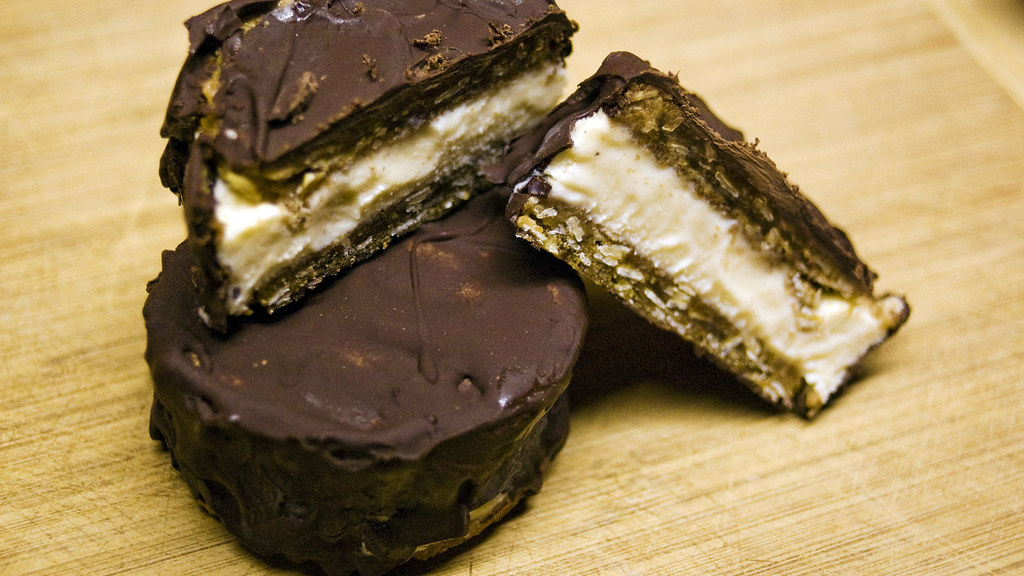 |
| It's-It style ice cream sandwiches, take two: Not an epic fail, but not great. You don't even want to see Round 1. |
That's right, I was ice cream slinger and faux-pastry chef at a fucking Baskin-Robbins. Despite being the confectionery equivalent of the guy manning the fryolator – see, any asshat blogger can puff up his irrelevant culinary past – I could write the preamble to the Constitution on the face of a half-sheet cake in buttercream, make waffle cones that could stand up to four gigantic scoops of ice cream plus hot fudge, and most relevant to our mission here, I could turn out a perfect ice cream sandwich in 20 seconds flat.
That was then. This is now. I no longer have the ability to properly hold an offset spatula let alone put a tip on a piping bag. Which is exactly what our first attempt at homemade It's-It called for. We tried the recipe and technique we Googled on Gastroanthropology. And it was a big bag of fail.
This is not to knock Gastroanthropology's technique. In fact, it's not only well-researched and professional, but if we had a proper setup it would probably work. But in a sweatbox of an apartment with merely an icebox for a freezer, it just wasn't meant to be. Ice cream soft enough to be piped out of a pastry bag would actually continue to melt faster than it could re-freeze in our piddly little freezer. And it did. We disappointingly opened up the freezer to find cowboy cookies frozen into a flat puddle of ice cream. At least the oatmeal discs were perfectly round, using the biscuit cutter technique from the above recipe.
Round 2 was much better (see photo above), but it still wasn't quite right. Instead of softening ice cream and piping it out of a bag, we smoothed a bunch of it out into a tray and froze it overnight into a sheet; much as I did back in the day to create full-sheet ice cream cakes. I then punched out discs of ice cream using the same biscuit ring so they'd be the same diameter as the cookies. So far, so good. we then dipped them in melted dark chocolate and put them back in the freezer to set. Only they wouldn't fully set. Cutting or biting into the sandwiches would result in the ice cream smooshing and the chocolate breaking off in chunks.
We put the results up on Facebook, awaiting possible troubleshooting from our foodie friends. Most of them being San Franciscans, they also know what an It's-It is supposed to be like. Our own analysis blamed not only our technique but our ingredients. In trying to make a high-quality, wholesome version of – let's face it – junk food, we just couldn't get certain things right. Using unprocessed organic oats, the cookies were too tough. Single-origin organic Peruvian chocolate? Not as easy to use for coating as the confectioners' stuff cut down with soy lecithin.
And worst of all, we had doubts about using our favorite local ice cream. I first wrote about Mary Quarta's gelato for VINGT Paris and just nabbed today's ROTD for it on Yelp (my first in over two years!) and we've been going to taste her wares at least twice a week since she opened up shop in the Haut Marais. It was the first "complex ingredient" we've decided against making ourselves (I'm even making our cheeses for an upcoming shindig) because it's so good and non-industrial, there's no point.
But gelato is a far cry in texture and structure than standard American ice cream, and it looked as though Mary's sweetness was just too soft and yielding for the type of brutality we'd put it through. We couldn't think of a non-industrial alternative, so we started thinking about how we'll make our own ice cream, solely to fulfill our desire for It's-It.
Then tonight, Round 3 happened.
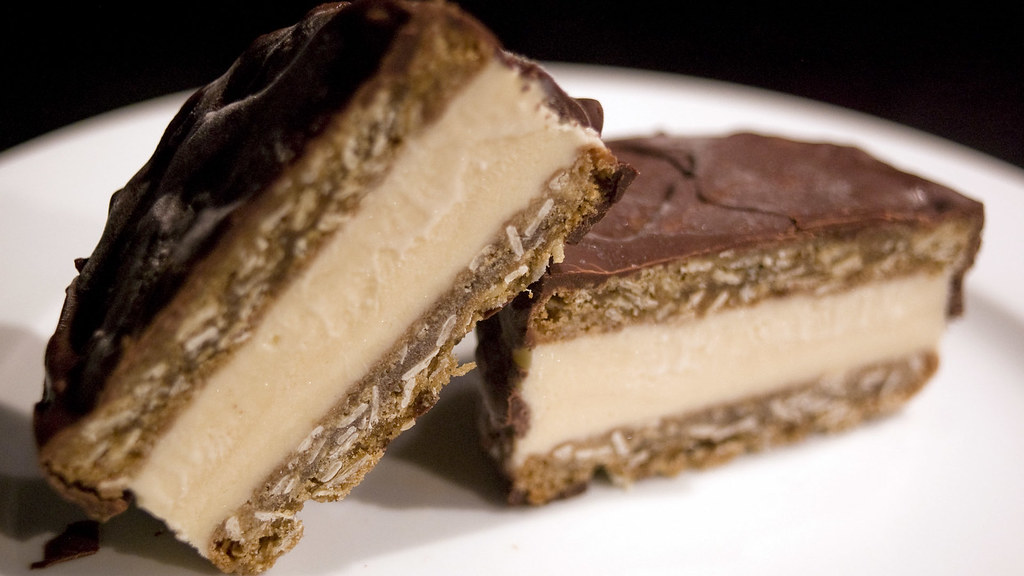 |
| Yup. Pretty much nailed it. And we didn't have to throw Mary under the bus, either. |
Now that we've got the formula down, we're going to make a few more tweaks: The cookies will have to be slightly crisper (and possibly thinner) for easy biting. We'll have to spend even more on a high-quality nappe (coating) dark chocolate that's thinner but lecithin-free – we will NOT compromise on quality. And now having figured out how to work with Mary's super-soft gelato, we'll stick with it, but surprisingly we're going to have to find flavors even more subtle than her already subdued crème à l'ancienne. Compared to typical American "vanilla" filler ice cream, Mary's is actually too flavorful and overpowers the cookies and chocolate by just a touch.
So here's the rundown of the technique we've got down so far:
- Spread Mary's gelato into a tray and freeze overnight
- In the meantime, make a batch of Alannah's cowboy cookies (possibly increase butter, decrease brown sugar? She's the expert and will figure it out...) flatten using biscuit cutter as a guide, and chill/freeze 'em
- Remove frozen gelato from tray and quickly punch out discs using biscuit cutter.
- Very quickly assemble sandwiches, put into fridge for at least two hours
- Double boil dark coating chocolate
- Brush chocolate on to very frozen sandwiches (also considering dunking via wire basket if we work with a huge quantity)
- Freeze yet again - probably overnight - in tray, sitting on parchment paper
- Eat
It's pretty long and involved, but after blissing out on the fruits of Round 3 tonight, it'll be worth it. And the more we do it, the better we'll get at it. The material cost and the learning curve will be high, but this is going to happen. Cuz that's what it's all about, reppin' the 415: Taking the seemingly casual and humble but obsessing over quality and source, and never compromising.
16 July 2010
Tabloid tacitly ADMITS GUILT, then gives credit to WRONG photo
It's summer, which calls for sipping chilled rosé outdoors (something we never did before going native) and taking advantage of the numerous terrasses Paris has to offer... That means it's time for slowing things down, taking the better part of a week off, watching fireworks, and eating a lot of salad.
From the simple...
To overly complex attempts at fusion...
It's time for chill attitudes and chilled veggies. In the meantime, the Huffington Post has quietly rectified their little uncredited content situation by giving me some credit for my work, but not all is rosy in amateur food blogger land.
I had complained rather loudly about not being credited for my awesome cheeseburger photo – more out of cheekiness than anything – and they very quietly went back and gave me credit for the photo. Furthermore, they even gave a link back to my Flickr page!
Unfortunately, they were a little overzealous in their corrections, and further gave me credit for the article's lead photo. One of Popeye's fried chicken.
Not that I mind having our noble family name on the front of Huffington Post's food section. But a) there's some other foodie photog out there who's not getting credit for his/her work in the field of 2-dimensional food facsimile, and b) it implies that I have the lousy taste to eat at Popeye's!
Mind you, Popeye's is the "Guilty Pleasure" selection of one of the chefs we madly respect. After reading his Momofuku Cookbook with much delight, David Chang cemented himself as one of our idols quite simply for doing things his way and turning a capricious middle finger at the food establishment. However, I ungraciously disagree with his love of Popeye's. I do admit to having eaten there. But I will not sacrifice the integrity of my endeavors by putting up a photo of carefully arranged "chicken" parts and styrofoam for the world to see.
So please, HuffPo editors, take more than 30 seconds when doing the – you know – editorial part of your job. So I won't look like some dweeb who loves Popeye's.
In the meantime, here's a look back at our rendition of fast food fried chicken: KFC vs. Local & Organic: An Epic Tale.
From the simple...
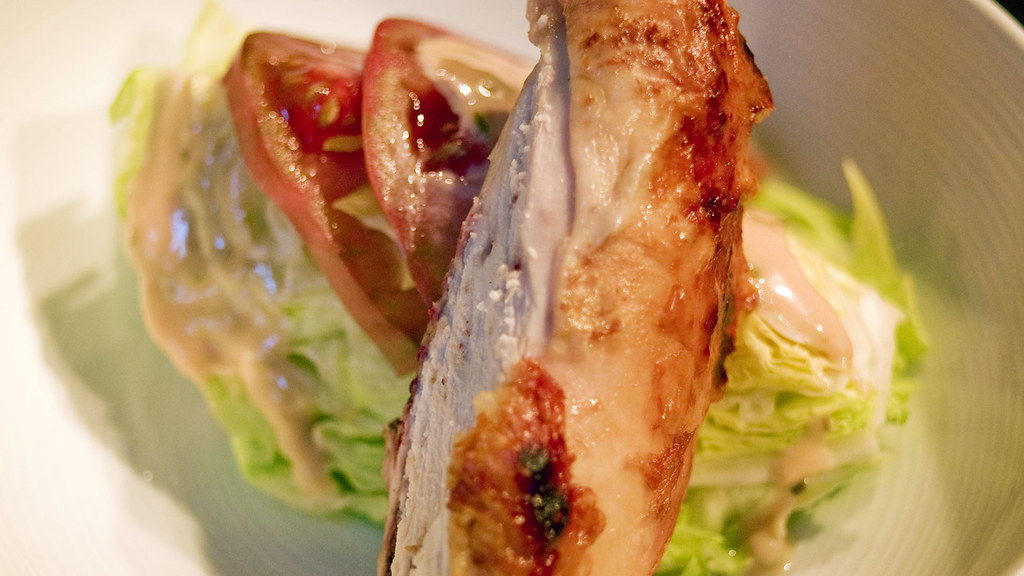 |
| Wedge of iceberg with heirloom tomatoes and homemade Thousand Island dressing and breast of rotisserie chicken |
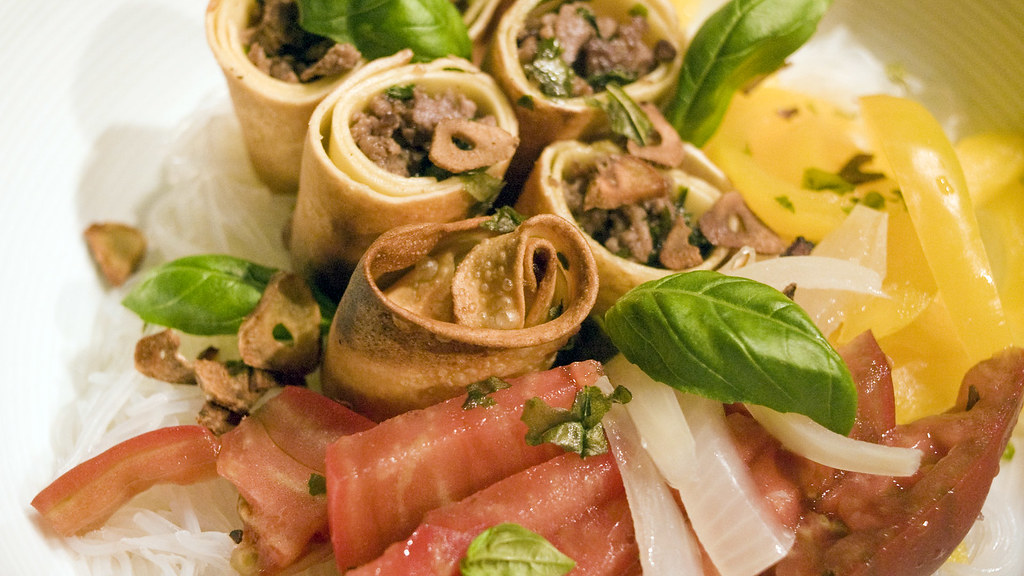 |
| An Italian take on classic Vietnamese – post forthcoming |
I had complained rather loudly about not being credited for my awesome cheeseburger photo – more out of cheekiness than anything – and they very quietly went back and gave me credit for the photo. Furthermore, they even gave a link back to my Flickr page!
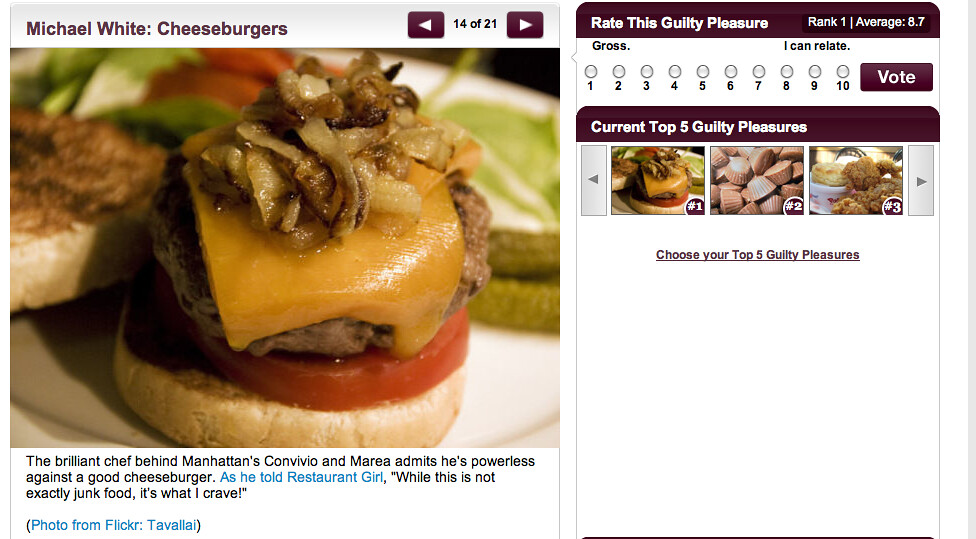 |
| Our kick-ass burger, with an appropriate photo credit. Yay! |
 |
| It may say "Tavallai" under the photo, but I assure you, we did NOT go to Popeye's! |
Mind you, Popeye's is the "Guilty Pleasure" selection of one of the chefs we madly respect. After reading his Momofuku Cookbook with much delight, David Chang cemented himself as one of our idols quite simply for doing things his way and turning a capricious middle finger at the food establishment. However, I ungraciously disagree with his love of Popeye's. I do admit to having eaten there. But I will not sacrifice the integrity of my endeavors by putting up a photo of carefully arranged "chicken" parts and styrofoam for the world to see.
So please, HuffPo editors, take more than 30 seconds when doing the – you know – editorial part of your job. So I won't look like some dweeb who loves Popeye's.
In the meantime, here's a look back at our rendition of fast food fried chicken: KFC vs. Local & Organic: An Epic Tale.
13 July 2010
Huffington Post STEALS content from Paris couple
Working my day job in a suburban office, there's not much that I actually want to eat at lunchtime around here. So I often bring in my lunch, or pick up a quick snack at a nearby supermarket and eat at my desk. Much of that time, I sit here eating my leftovers or neatly packaged salad and surf the Web, drooling over what I'd rather be eating. (Alannah, lucky her, has the kitchen to herself during the day, as well as the wealth of lunch spots central Paris offers.)
And while I deleted my Huffington Post account several months ago (too many knucklehead commenters, misleading sensationalist headlines, pointless slideshows to increase clicks/views), I admittedly do still peruse it once in a while. Talk about guilty pleasures!
So it was as I was flipping through the 20 Celebrity Chefs' Guilty Pleasures slideshow (ARGH!) that I paused on chef Michael White's selection of the humble hamburger. I took a look at the accompanying photo and thought to myself, "Damn, that's exactly how we'd construct a burger!"
I looked at it longer than I normally would in one of these infernal slideshows, admiring the thick but evenly melting cheese, the perfect diameter of the meat matching both the bun and the rondelle of tomato, and the perfectly caramelized grilled onions. You can't get burgers like that in Paris... Then it dawned on me: THAT'S OUR BURGER.
I was pretty proud for a moment, even if it was on a glorified content aggregation site. "There's our burger, and my photo of it got picked up... nice!" I was ready to shoot off an SMS to Alannah to tell her to look at it when she got the chance. Then my ego kicked in... Where's the photo credit? Where's the link to my Flickr page? Or a mention of our blog? Everyone else in the fucking slideshow got a credit! WTF, man!?
Listen - we don't do this for money. We started Hungry Amateurs as a way of keeping up-to-date with our foodie friends back at home, sharing a little bit of food porn on the regular. It's just food geekery and fun, and far from what you'd call a for-profit venture. (The ads bring in about enough money per year to buy a few beers.) We're doing it for love. I put up almost all of my photos - food, travel or otherwise - under a Creative Commons attribution/no derivatives license so that anyone who likes them can use them. All I ever ask is that I be credited/linked back for the photo.
So it's all about principle. I create a shit-ton of content. All I ever ask for is a little credit. Capisce?
To be honest, I'm not at all outraged. If anything, I'm flattered, especially since my little snapshot here is currently #1 in the slideshow's user ratings. Hooray for all that. But I'll be damned if for once, I don't jump on the chance to turn the tables and make up a click-whoring headline about the Huffington Post.
And while I deleted my Huffington Post account several months ago (too many knucklehead commenters, misleading sensationalist headlines, pointless slideshows to increase clicks/views), I admittedly do still peruse it once in a while. Talk about guilty pleasures!
So it was as I was flipping through the 20 Celebrity Chefs' Guilty Pleasures slideshow (ARGH!) that I paused on chef Michael White's selection of the humble hamburger. I took a look at the accompanying photo and thought to myself, "Damn, that's exactly how we'd construct a burger!"
I looked at it longer than I normally would in one of these infernal slideshows, admiring the thick but evenly melting cheese, the perfect diameter of the meat matching both the bun and the rondelle of tomato, and the perfectly caramelized grilled onions. You can't get burgers like that in Paris... Then it dawned on me: THAT'S OUR BURGER.
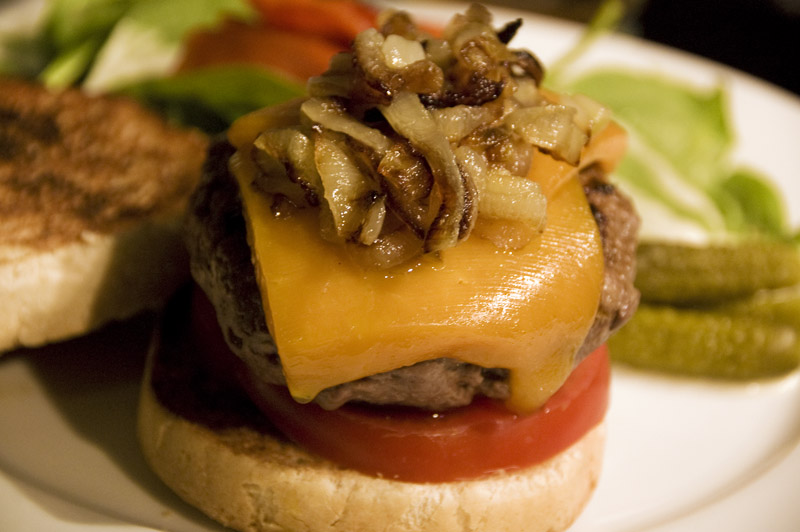 |
| From our post Rant: Eat American, Même en France |
Listen - we don't do this for money. We started Hungry Amateurs as a way of keeping up-to-date with our foodie friends back at home, sharing a little bit of food porn on the regular. It's just food geekery and fun, and far from what you'd call a for-profit venture. (The ads bring in about enough money per year to buy a few beers.) We're doing it for love. I put up almost all of my photos - food, travel or otherwise - under a Creative Commons attribution/no derivatives license so that anyone who likes them can use them. All I ever ask is that I be credited/linked back for the photo.
So it's all about principle. I create a shit-ton of content. All I ever ask for is a little credit. Capisce?
To be honest, I'm not at all outraged. If anything, I'm flattered, especially since my little snapshot here is currently #1 in the slideshow's user ratings. Hooray for all that. But I'll be damned if for once, I don't jump on the chance to turn the tables and make up a click-whoring headline about the Huffington Post.
08 July 2010
Auf Wiedersehen, Paul
For anyone following along with us on Twitter or Facebook or – gasp – real life over the last couple of weeks (though obviously not here, as we've not been cooking much thanks to jungle heat and a busted-ass kitchen), we've been rooting for Japan and Germany in the World Cup. This has nothing to do with any love for the old Axis – we laughed heartily when Italy's theatre troupe got booted. No, we just felt an affinity with a couple of young teams considered too inexperienced to do much of anything yet who somehow were putting on clinics against the established order.
That and the nicknames "Mannschaft" and "Blue Samurai" sound like fun toys.
At any rate, once Japan was out, we put all our emotional chips on Germany. We rallied with the handful of Germans in Paris at one of the very few German bars in town for every match, drinking litres of Paulaner, eating Currywurst and Bratwurst like it was going out of style, and cheering roaringly (yet in an ever so orderly and polite manner) for every goal. And there were a lot of them.
Then that slimy Paul the Psychic Octopus came along and picked Spain to beat Germany in the semi-finals. It turned out that that mother bitch of a mollusk was right, and we ended up leaving our local Bier und Bratwurst bar all heartbroken. Vowing to eat Paul, of course. We weren't the only ones with the idea, but none of our friends on the other side of the border have gloated about eating octopus today.
So in honor of our fallen second-favorite team, we have stepped up to the plate. We hereby present fellow fans of the Mannschaft a couple of octopus dishes we worked out tonight.
Almost every western preparation of octopus sounds like the one proposed in the second article linked above: Grill it and garnish with olive oil, lemon juice, and garlic. It's good, but dammit, it reminds me too much of time spent rolling around naked, chugging wine and eating seafood on the beaches of... you guessed it... Spain. Hmph! What to do?
Before leaving the office this evening I called Alannah to let her know I'd be stopping by the Asian market to pick up some octopus. "I need flat-leaf parsley. And a lemon. Must. Have."
I didn't tell her what I was up to, but I was inspired by Fergus Henderson's parsley salad (which he serves with his signature roasted marrow bones). We tossed some flat-leaf parsley and finely sliced onion with salt, lemon juice and olive oil, and topped the salad with bite-sized pieces of octopus tentacle pan-grilled with the tried and true olive oil, lemon juice, and finely chopped garlic. A little Spanish. A little English. Simple. Delicious. Vindictive.
And delightfully refreshing with a pint of lager on a ridiculously hot, muggy summer night, if you're looking for the right beverage.
The second dish isn't quite as fit for a mosquito-ridden Parisian summer, but we simply had to do right by Deutschland. I basically pounded a "filet" of octopus tentacle with the rough side of a meat tenderizer, dredged it through an egg, floured it and fried it. There: Octopus Schnitzel. Throw a squeeze of lemon on it and you're good to go.
Alannah seriously stepped things up. She's good with Späetzle, a German egg pasta made with an equal amount of flour and egg, and enough milk to make it viscous and goopy (but not liquidy). The easiest recipe calls for two eggs, 1 cup of flour and a 1/4 cup of milk. This makes more than enough for two people. We added a pinch of salt but skipped the usual nutmeg for a different magic ingredient: Squid ink – about a tablespoon of it. (Octopus ink would've been more appropriate, but where the hell do you get that? And does it taste the same? Let us know.)
To cook Spätzle (blackened by squid-ink or not), you squeeze your viscous goo through the holes of a strainer into a pot of salted hot water. Let the Spätzle cook for a few minutes (if they're floating, they're done) and pull out with a slotted spoon into an oiled or buttered bowl. This keeps them from sticking. Before serving, toss with butter or olive oil. (I broke the rules and used both, without telling Alannah.)
The end result was even better than anticipated. While an octopus Schnitzel may sound 10 shades of wrong, it came out remarkably light and paired really well with the slightly squid-y Späezle.
Germany may be known more for beer, precision engineering, and Scheiße videos than for seafood, but by applying German technique to cephalopods, the results are pretty damn good.
So there you have it. It may not be Paul the Psychic Octopus himself, but we nailed one of his cousins good n' hard.
That and the nicknames "Mannschaft" and "Blue Samurai" sound like fun toys.
At any rate, once Japan was out, we put all our emotional chips on Germany. We rallied with the handful of Germans in Paris at one of the very few German bars in town for every match, drinking litres of Paulaner, eating Currywurst and Bratwurst like it was going out of style, and cheering roaringly (yet in an ever so orderly and polite manner) for every goal. And there were a lot of them.
Then that slimy Paul the Psychic Octopus came along and picked Spain to beat Germany in the semi-finals. It turned out that that mother bitch of a mollusk was right, and we ended up leaving our local Bier und Bratwurst bar all heartbroken. Vowing to eat Paul, of course. We weren't the only ones with the idea, but none of our friends on the other side of the border have gloated about eating octopus today.
So in honor of our fallen second-favorite team, we have stepped up to the plate. We hereby present fellow fans of the Mannschaft a couple of octopus dishes we worked out tonight.
 |
| Parsley salad with octopus tentacles |
Before leaving the office this evening I called Alannah to let her know I'd be stopping by the Asian market to pick up some octopus. "I need flat-leaf parsley. And a lemon. Must. Have."
I didn't tell her what I was up to, but I was inspired by Fergus Henderson's parsley salad (which he serves with his signature roasted marrow bones). We tossed some flat-leaf parsley and finely sliced onion with salt, lemon juice and olive oil, and topped the salad with bite-sized pieces of octopus tentacle pan-grilled with the tried and true olive oil, lemon juice, and finely chopped garlic. A little Spanish. A little English. Simple. Delicious. Vindictive.
And delightfully refreshing with a pint of lager on a ridiculously hot, muggy summer night, if you're looking for the right beverage.
 |
| Octopus Schnitzel over squid ink Spätzle. Tell your German friends it's "Kaviar" |
Alannah seriously stepped things up. She's good with Späetzle, a German egg pasta made with an equal amount of flour and egg, and enough milk to make it viscous and goopy (but not liquidy). The easiest recipe calls for two eggs, 1 cup of flour and a 1/4 cup of milk. This makes more than enough for two people. We added a pinch of salt but skipped the usual nutmeg for a different magic ingredient: Squid ink – about a tablespoon of it. (Octopus ink would've been more appropriate, but where the hell do you get that? And does it taste the same? Let us know.)
To cook Spätzle (blackened by squid-ink or not), you squeeze your viscous goo through the holes of a strainer into a pot of salted hot water. Let the Spätzle cook for a few minutes (if they're floating, they're done) and pull out with a slotted spoon into an oiled or buttered bowl. This keeps them from sticking. Before serving, toss with butter or olive oil. (I broke the rules and used both, without telling Alannah.)
The end result was even better than anticipated. While an octopus Schnitzel may sound 10 shades of wrong, it came out remarkably light and paired really well with the slightly squid-y Späezle.
Germany may be known more for beer, precision engineering, and Scheiße videos than for seafood, but by applying German technique to cephalopods, the results are pretty damn good.
So there you have it. It may not be Paul the Psychic Octopus himself, but we nailed one of his cousins good n' hard.
14 June 2010
Toss This Salad
A week in Italy is a beautiful thing. Especially when you can largely eschew the restaurants and cook simply for yourself. The trouble is that in a land largely known for its meats and cheeses and gelatos, you pretty much mostly eat meats and cheeses and gelatos. (Don't talk to me about the unsalted bread.) And let's not forget about the pasta.
When you eat nothing but proteins and starches for a week, things in your body slow down. You get lethargic. You move less nimbly. You prefer to do everything laying down. So when we got home, I laid on the couch with a meat and gelato hangover. Alannah found the will to hit the market and go up to the kitchen.
After some banging around, I wondered what in tarnation was going on. Was she actually cooking a full meal up there? Would I have to call a surgeon in Neuilly (Paris' Beverly Hills) to make a liposuction appointment? Is my wife mad to bother feeding us after a trip like we had?
The result was a ginormous salad, replete with half a head of red-leaf lettuce, lightly blanched broccoli (raw broccoli is for hippie), red peppers grilled under the broiler, fresh cucumber, and plenty of coeur de pigeon (pigeon heart, what kind of name is that!?) tomatoes. Drizzled with a touch of vinegar, a hit of salt, and plenty of our favorite olive oil, it was the antidote to a week of overindulgence.
Upon consuming what seemed like 2 kilos of nothing but vegetables, a wave of healthiness swept over us. Perhaps too much, so we high-tailed it to our neighborhood gelato joint for an appropriate Italian dessert.
Realizing that this much vegetable at once can constitute a shock to the system, our next meal incorporated one of the most fabulous ingredients we happened upon in Italy: Cuore di Proscuittuo. If you think Parma ham is something amazing, imagine this, the filet mignon of the ham. This is seriously drool-inducing stuff.
Normally you'd use one of those circular deli-style meat slicers to cut this stuff to the fineness it deserves, but we're amateurs here, remember? But even with our insanely sharp knives (the ones we didn't have with us in Italy...) it's tough to cut ham deli-thin. The solution? Cut "normal" slices, lay it down on the cutting board, then horizontally make slices from the slices sushi style. This way you get delicate, manageable strips without having chef's salad-type matchsticks whose rough shape interferes with the enjoyment of such refined hammy flavors.
We again went with a bed of red-leaf lettuce, coeur de pigeon tomatoes and a tiny bit of cucumber, topping it with a nice helping of cuore di proscutto and freshly shaved Parmesan. A bit clichéd, sure, but I opted for a balsamic vinaigrette this time for a hint of sweetness to go with the salt from the cheese and ham.
The one touch that really made this magical, in my most humble opinion, was using several whole leaves of basil to garnish the salad. The occasional but powerful punch of basil rounds out the salad with a perfect balance of flavor, and distinguishes it from typical meat-based meal salads you get at your typical workaday lunch spot.
When you eat nothing but proteins and starches for a week, things in your body slow down. You get lethargic. You move less nimbly. You prefer to do everything laying down. So when we got home, I laid on the couch with a meat and gelato hangover. Alannah found the will to hit the market and go up to the kitchen.
After some banging around, I wondered what in tarnation was going on. Was she actually cooking a full meal up there? Would I have to call a surgeon in Neuilly (Paris' Beverly Hills) to make a liposuction appointment? Is my wife mad to bother feeding us after a trip like we had?
 |
| There. This oughtta make you regular enough to star on German video sites. |
Upon consuming what seemed like 2 kilos of nothing but vegetables, a wave of healthiness swept over us. Perhaps too much, so we high-tailed it to our neighborhood gelato joint for an appropriate Italian dessert.
Realizing that this much vegetable at once can constitute a shock to the system, our next meal incorporated one of the most fabulous ingredients we happened upon in Italy: Cuore di Proscuittuo. If you think Parma ham is something amazing, imagine this, the filet mignon of the ham. This is seriously drool-inducing stuff.
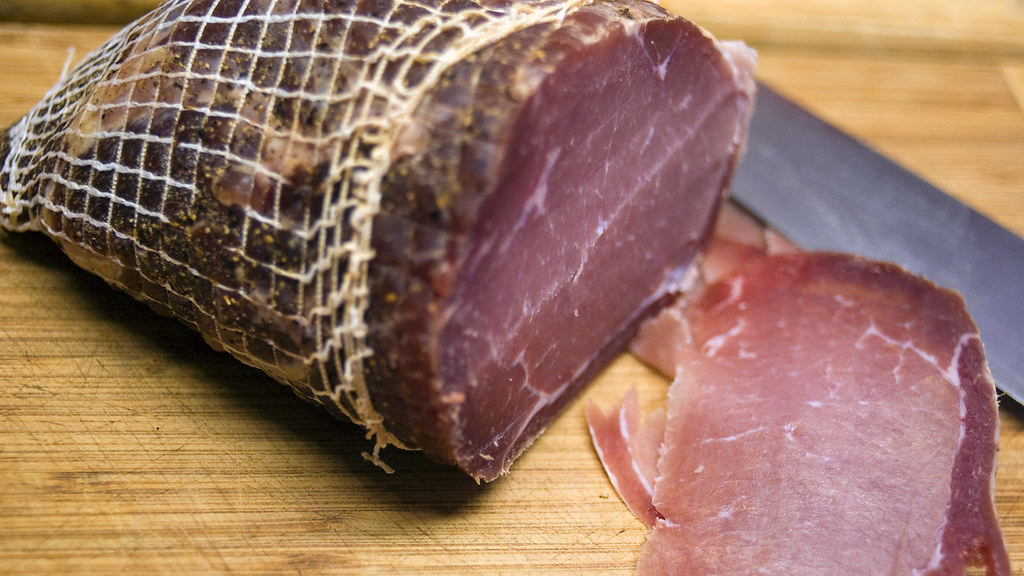 |
| Handle this meat with care. |
We again went with a bed of red-leaf lettuce, coeur de pigeon tomatoes and a tiny bit of cucumber, topping it with a nice helping of cuore di proscutto and freshly shaved Parmesan. A bit clichéd, sure, but I opted for a balsamic vinaigrette this time for a hint of sweetness to go with the salt from the cheese and ham.
 |
| Moist & glistening. |
09 June 2010
On the road: Funky Porcini
This post has nothing to do with the downtempo nu-jazzy act. While they're quite good, we're talking about the mushrooms. Which, in my humble opinion, are even better.
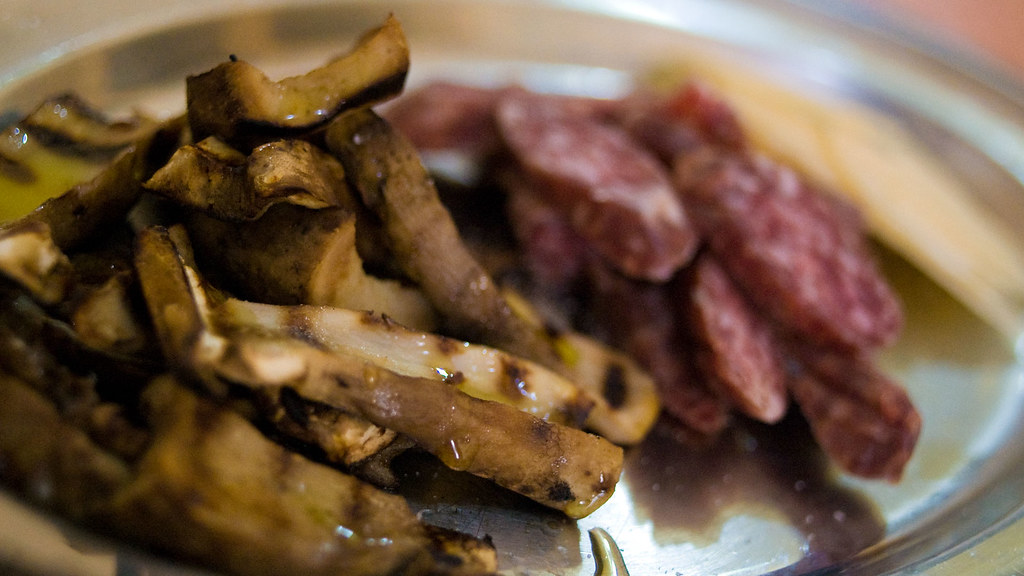 |
| Mangia, mangia! |
During our stay in Italy last week, we were both blessed and cursed by having an apartment with a full kitchen. Blessed because we'd save on all the ridiculous cover charges, service charges, and other "surprise" costs involved in dining in Italy. And further blessed because we'd have a gas range. Cursed because it was – as expected – all equipped with crap from Ikea.
Anyway, I'd begged and pleaded with Alannah all night to do it.
And after she'd said no to all that, I'd asked politely if we could take our knives to Italy with us.
"No! We are NOT putting the knives into checked baggage. If you wanted to do that, we should've booked a train..." And that was that. We'd be traveling knifeless.
"No! We are NOT putting the knives into checked baggage. If you wanted to do that, we should've booked a train..." And that was that. We'd be traveling knifeless.
Despite nearly losing a few fingers due to dull, serrated (!?) Ikea kitchen knives supplied at the apartment, we did pull off a few good dishes. Sure, we had to tone down our usual schtick in the presence of kids – but it also made for some fun improvisation. (What do you feed kids who almost only want Persian food when you have Tuscan ingredients?)
But it was less about the tools or limitations or even our abilities than it was about the fresh food, and Florence has that in spades. And it's cheap. Perhaps we say that through the distorted filter of Parisian living, but hitting the Mercato Centrale every day seemed like a bargain. We were able to get fresh, high-quality ingredients for a drop in the bucket.
If you ever get a board full of antipasti at a proper Italian restaurant, you may think, "Geez, they put no work into this," well, that's the point. As almost an antithesis to elaborated French cuisine, much Italian cuisine is about taking the stuff and presenting it in its simplest form. This isn't to say that there isn't a lot of work going on – but it's usually happening on the supplier's end. It takes skill and knowledge to raise a boar, butcher it, and hunt the truffles to make a salsiccia di cinghiale al tartufo. But on your end, you bring it home from the salumeria, slice it up, and serve it with a robust wine from around Siena. Done.
So in that spirit, we decided to put together a nice aperitivi. After a day of touristing, juggling kids, and checking out Tuscan rear ends (I swear, despite the gaudy clothes surrounding them, even Alannah will agree that the women of Tuscany have the nicest asses ever) it was tough to get out to a bar and partake. The aperitivi is a northern Italian (but widely spreading) norm akin to the American happy hour buffet, where the spread is often simple fare like cheeses, olives, various cured meats, and other finger foods.
One night we opted to go for a very simple spread of melons, shaved parmesano reggiano, tender chunks of truffled boar sausage, and – it goes without saying – porcini mushrooms. Porcinis (called cêpes in France) are crazy expensive on this side of the alps. But in Italy, the spring funghi are surprisingly affordable, and abundant. Not bad for something that can't be commercially cultivated. So while €10/kilo for fresh ones might sound like a lot for mushrooms, it's actually a bargain.
The trick with porcinis is keeping it simple. Whenever you have fancy ingredients, you want to taste them. Otherwise, why bother paying so much? The other trick is to use them fast. While the dry ones keep forever, the fresh ones are incredibly sensitive to heat and moisture and can go slimy in less than a day if conditions aren't playing nice. Then you'll really have Funky Porcini. The bad kind.
My favorite is to slice them up about a quarter inch thick and grill them. They're a "meaty" mushroom, so it's perfectly OK to make like Rocco Siffredi and treat 'em like pieces of meat. Luckily, the apartment came equipped with a grill pan (albeit in cast aluminum... how cheap!) so we were all good.
Simply the grill pan with a very thin layer of olive oil. Not for actually cooking the mushroom, but because of its low smoking point, it can be burnt a little to impart some smokiness to the mushrooms. Slap the 'shrooms on 'til you have good grill marks on both sides.
And that's about it. Throw it on a plate, sprinkle with sea salt, and hit it with some good olive oil and you have a finger food that's at once decadent and humble. It tastes expensive but earthy. Smells strong but eases across the palate gently. And it goes damn well with all sorts of wine.
Pro tip from the amateurs:
We were asked last week how we shave it. To avoid nicks and cuts, take long, gentle strokes with a vegetable peeler. This way your parmesan (or other hard cheeses) will come out in fine strips that look pretty, feel good in the mouth, and glisten beautifully under drippings of olive oil.
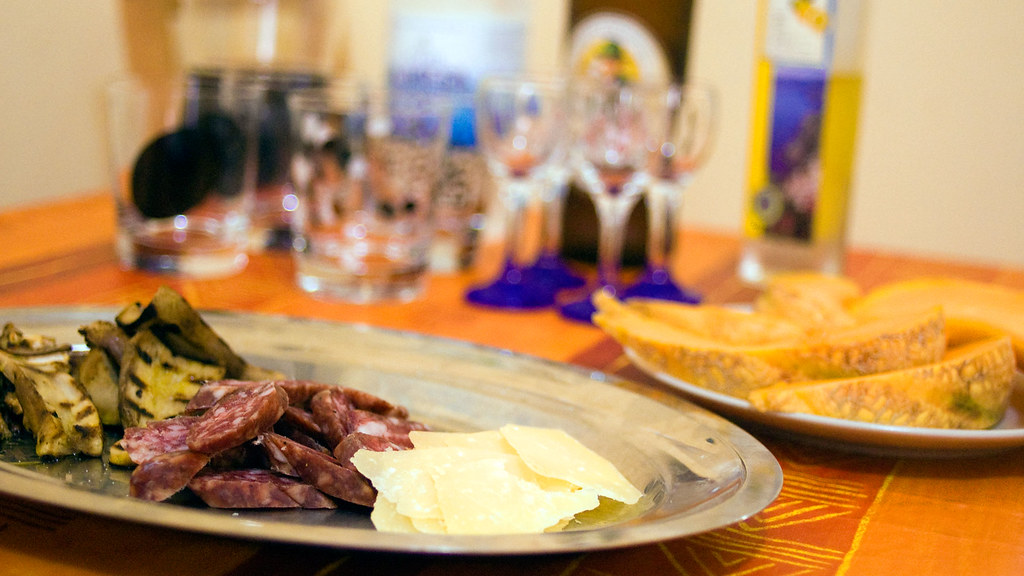 |
| Aperitivi a casa |
One night we opted to go for a very simple spread of melons, shaved parmesano reggiano, tender chunks of truffled boar sausage, and – it goes without saying – porcini mushrooms. Porcinis (called cêpes in France) are crazy expensive on this side of the alps. But in Italy, the spring funghi are surprisingly affordable, and abundant. Not bad for something that can't be commercially cultivated. So while €10/kilo for fresh ones might sound like a lot for mushrooms, it's actually a bargain.
The trick with porcinis is keeping it simple. Whenever you have fancy ingredients, you want to taste them. Otherwise, why bother paying so much? The other trick is to use them fast. While the dry ones keep forever, the fresh ones are incredibly sensitive to heat and moisture and can go slimy in less than a day if conditions aren't playing nice. Then you'll really have Funky Porcini. The bad kind.
My favorite is to slice them up about a quarter inch thick and grill them. They're a "meaty" mushroom, so it's perfectly OK to make like Rocco Siffredi and treat 'em like pieces of meat. Luckily, the apartment came equipped with a grill pan (albeit in cast aluminum... how cheap!) so we were all good.
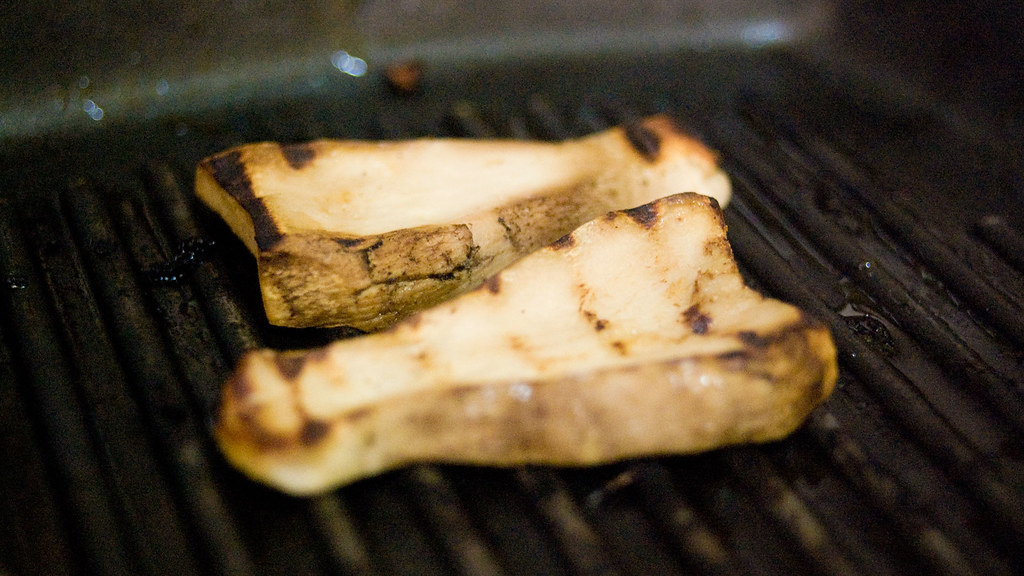 |
| Grill, baby, grill |
And that's about it. Throw it on a plate, sprinkle with sea salt, and hit it with some good olive oil and you have a finger food that's at once decadent and humble. It tastes expensive but earthy. Smells strong but eases across the palate gently. And it goes damn well with all sorts of wine.
Pro tip from the amateurs:
We were asked last week how we shave it. To avoid nicks and cuts, take long, gentle strokes with a vegetable peeler. This way your parmesan (or other hard cheeses) will come out in fine strips that look pretty, feel good in the mouth, and glisten beautifully under drippings of olive oil.
01 June 2010
Quick Hit: Meat Hole
 |
| Click for a ridiculously high-def photo |
After just over two years in Paris, it must be rubbing off on us: We followed some alarmingly stupid food trend. The other day, after making doughnuts, we thought "Why the hell not?" and made the infamous Doughnut Burger (aka "The Luther" after supposed aficionado Luther Vandross), which has been immortalized by the likes of Vandross himself, Southern dame Paula Deen, and minor league baseball parks across the US.
Of course, we didn't use factory-churned Krispy Kremes and frozen patties. We used our own homemade doughnuts, of course, fresh beef ground for us by the butcher just moments before, and the same formula for near-perfect fries that we did on Cinco de Mayonnaise. (Courtesy of the crafty bloggers at the French Culinary Institute.)
The verdict?
DISGUSTING.
An utter waste of quality ingredients, to be quite frank.
I'd already posted a photo on Facebook some time ago, where a discussion ensued among friends...
 |
| Some meat for your hole, madam? |
...but now, on the eve of a so-called "Street Food" event in Paris featuring burgers (even though it's far from actual street food, considering none of the star chefs involved have ever pushed a cart through Paris), I thought it our responsibility to unleash upon the general public the horrible truth about mixing quality cuisine with flash-in-the-pan trends.
You're welcome.
18 May 2010
Dirty Dozen
Look at that tight, little star-shaped hole, glazed with sticky icky goodness.
We're talking about doughnuts, of course. When we first started this site full of horrible double-entendres in early 2009, we did it to show off a bit of homespun food porn, starting with our attempt to make doughnuts.
In nearly a year and a half, we've come full circle. We've gotten better at finding ingredients. We've gotten better at working on techniques. And we still haven't been able to bust a decent frickin' 'nut in Paris. Sure, dozens of American (or American-style) "coffee shops" sell doughnuts, but good luck getting anything other than a hockey puck that's been sitting in a refrigerated case for days on end.
We gave up ages ago. We didn't even really eat doughnuts back in the States anyway. Then, the other night on a lark (or rather because of discounted tickets), we figured we'd go see Iron Man 2 at the shitty chain theatre nearby. Those fantasies you have of Paris being intellectual and artsy? We tossed 'em ages ago.
Anyway, there's this scene in IM2 where Robert Downey Jr. is sitting in the hole of the famous Randy's Donuts in LA, eating a doughnut. At that moment, I turned to Alannah and said, "I want a doughnut." She turned to me and said, "Me too!"
This isn't slang for a dirty act in public, but what married people actually say to each other.
The trouble is, for all the craptacular chains we've got surrounding us, not one of them makes doughnuts. The UK has imported Krispy Kreme. Spain has been invaded by Dunkin. We, on the other hand, got nothin'. So we went to bed, as we're wont to do.
At some point the next day, I looked in the fridge and saw a mixing bowl of some kind of dough. "You didn't..." I started to say to Alannah. "Yes I did," she replied. She'd used the dough part of some sour cream doughnut recipe on Epicurious and modified it to use yogurt instead, and much less orange zest. And it was beautiful. She rolled out the dough and cut it into shapes.
The last time we made doughnuts, we got better results on the holes, and it took a lot of experimenting with oil temperatures and frying times. This time I bowed down to Thomas Keller's French Laundry Cookbook and used the temp and times for his "Coffee and Doughnuts": 30 seconds on one side, 1 minute on the other, and back to 30 seconds on the first at 160ºC/325ºF.
While TK's formula is for raised (yeast) doughnuts, it worked perfectly for Alannah's adaptation of the Epicurious cake (old-fashioned) doughnuts. In fact, the crumb is damn near perfection.
We made a few experimental doughnuts, as well as a bunch of holes and coated them with cinnamon-sugar for a round of overindulgent taste-testing.
Having successfully completed our test round, it was time to go whole hog and make a dozen proper doughnuts. After all, American food deserves American quantities.
As much as I love all things naked, I don't care much for an undressed doughnut. I told Alannah I'd make her a nice, gooey glaze, and after she was done rolling her eyes, I actually got to the business of making some out of powdered sugar and liquid. (You need about an 8:1 ratio.) Powdered sugar and milk with a touch of vanilla for standard glaze. Powdered sugar and maple syrup and a touch of butter for maple glaze. And powdered sugar and melted milk chocolate for chocolate glaze.
Keep your glazes warm in a bowl, dip your 'nuts in, then rack 'em for at least five minutes 'til it's all firm. Then it's ready to shove in your mouth.
We've had several doughnuts since making the batch, and I'm already kind of sick of 'em. They're damn good, but like I said, we never really ate doughnuts that much in the US to begin with. It's just that once in a while you get a craving for something you can't have, so you just have to go out and grab it for yourself. After all, the only way to get rid of temptation is to yield to it, right?
That's what we've been doing much of the time since that first post. And we've since discovered that almost anything can be made better at home. When you do it yourself, it's more fun, more involved, and more personal. The same applies to cooking.
In fact, despite the fact that we probably won't make them again for another year and a half (and when we do, it'll be raised doughnuts!), we found that doughnuts give us the perfect synergy in the kitchen.
As the anal type (as in, she's the baker, sheesh!) Alannah's great with measurements and feeling out the proofing of a dough. As the sloppy bastard who eschews recipes, I'm better suited for the other part: Operating a deep fryer.
 |
| Amateur money shot |
In nearly a year and a half, we've come full circle. We've gotten better at finding ingredients. We've gotten better at working on techniques. And we still haven't been able to bust a decent frickin' 'nut in Paris. Sure, dozens of American (or American-style) "coffee shops" sell doughnuts, but good luck getting anything other than a hockey puck that's been sitting in a refrigerated case for days on end.
We gave up ages ago. We didn't even really eat doughnuts back in the States anyway. Then, the other night on a lark (or rather because of discounted tickets), we figured we'd go see Iron Man 2 at the shitty chain theatre nearby. Those fantasies you have of Paris being intellectual and artsy? We tossed 'em ages ago.
Anyway, there's this scene in IM2 where Robert Downey Jr. is sitting in the hole of the famous Randy's Donuts in LA, eating a doughnut. At that moment, I turned to Alannah and said, "I want a doughnut." She turned to me and said, "Me too!"
This isn't slang for a dirty act in public, but what married people actually say to each other.
The trouble is, for all the craptacular chains we've got surrounding us, not one of them makes doughnuts. The UK has imported Krispy Kreme. Spain has been invaded by Dunkin. We, on the other hand, got nothin'. So we went to bed, as we're wont to do.
At some point the next day, I looked in the fridge and saw a mixing bowl of some kind of dough. "You didn't..." I started to say to Alannah. "Yes I did," she replied. She'd used the dough part of some sour cream doughnut recipe on Epicurious and modified it to use yogurt instead, and much less orange zest. And it was beautiful. She rolled out the dough and cut it into shapes.
 |
| Doughnuts and stars. Much more organized this time around. |
While TK's formula is for raised (yeast) doughnuts, it worked perfectly for Alannah's adaptation of the Epicurious cake (old-fashioned) doughnuts. In fact, the crumb is damn near perfection.
 |
| Exhibit A: Cross section of cake doughnut with perfect crumb. |
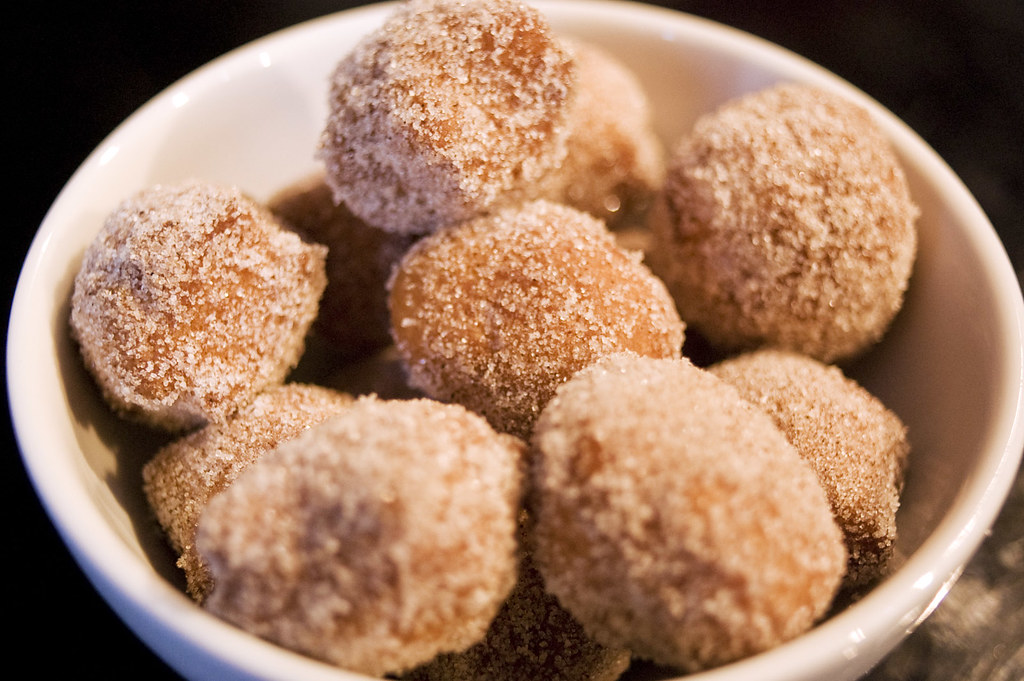 |
| A-holes and O-holes: An Alannah and Omid production. |
 |
| Nice (cooling) rack! |
Keep your glazes warm in a bowl, dip your 'nuts in, then rack 'em for at least five minutes 'til it's all firm. Then it's ready to shove in your mouth.
 |
| A threesome of each: Glazed, cinnamon-sugar, maple and chocolate. |
That's what we've been doing much of the time since that first post. And we've since discovered that almost anything can be made better at home. When you do it yourself, it's more fun, more involved, and more personal. The same applies to cooking.
In fact, despite the fact that we probably won't make them again for another year and a half (and when we do, it'll be raised doughnuts!), we found that doughnuts give us the perfect synergy in the kitchen.
As the anal type (as in, she's the baker, sheesh!) Alannah's great with measurements and feeling out the proofing of a dough. As the sloppy bastard who eschews recipes, I'm better suited for the other part: Operating a deep fryer.
13 May 2010
Italian Stallion
We don't go out for Italian much. Good Italian food is a rip-off in Paris. Despite being right next door to France, the local idea of Italian food seems to be underflavored pizza slathered in chili-infused olive oil, or pasta served in bucket-sized Chinese take-out containers. Sure, there are a few outstanding Italian-run places (there's a Slow Food affiliated salumeria in our neighborhood that destroys the competition), but they're not too easy on the ol' immigrant pocketbook. (Ironic, eh?)
Alannah and I used to have Sunday "date nights" which usually involved a movie of some sort and a long, languid three-courser at our local Italian joint in San Francisco. It was cheap. It was a chain. But it was good. Now, being denied all that, I whip up a meal that might be date-worthy, and we download something to watch on BitTorrent.
The trouble is that – going all crazy with the simulating date night thing – we'd get too fancy, forgetting that the great thing about Italian cuisine is that when you have excellent ingredients (which we pretty much always have access to, even on the cheap) it need only be simple. So we started looking more closely at how non-restaurant Italian food works...
Extra motivation was provided when cousins from the US told us they're going to Italy this summer, and that we should join them, renting a house in Umbria or Tuscany. Alannah started fantasizing about making like Diane Lane in Under the Tuscan Sun, lolling about on the terrace as we put away bottles of Chianti and Brunello di Montalcino. I started fantasizing about making it with Diane Lane. (Umm, hello, she might be old, but have you *seen* Unfaithful??) The best part would be having our own kitchen, meaning we could stock up on local ingredients and avoid being ripped off at restaurants.
So the last few weeks have involved a lot of experimentation. Some of it in the kitchen, trying out a marathon of Italian "basics" so we can treat our US brethren to our cooking without looking like back-assward Parisians, scaring the kids with our salacious organs. (You know, kidneys, livers and the kind.)
Yes, there will be kids with us, so our adventures in Italy will be strictly rated PG. Or "-10" as they say here in France.
And kids like spaghetti. I like spaghetti. Just about every idiot knows how to make spaghetti.
Then we watched the "Techniques" episode of Anthony Bourdain: No Reservations (thanks, BT!) and thought, "We gotta make that spaghetti." And after making the featured recipe by Scott Conant of Scarpetta, we'll never make spaghetti the same way again. You know, except for those 8 months of the year when we can't get organic tomatoes straight from Sicily. Hey man, I told you we have access to great produce – just not year-round. It's a seasonality thing.
Flipping channels one night, we found some Canadian show about some guy who goes around Italy cooking outdoors. I have no idea what it's called, nor who the guy is. It's all dubbed in French. All I know is that he keeps it really simple, picking up local ingredients and doing very little to them. But I found myself drooling. "This," I declared to Alannah as I leaned over to her on the couch, "is how I want to do it in Italy." We subsequently talked about food.
The most complicated thing I learned was foccacia. Which is essentially pizza dough. Flour. Water. Yeast. A pinch of sugar and salt. Some olive oil. Garnish with chopped anything. (We went with slivers of onion and olive.) Bake at maximum heat for no more than 10 minutes. Serve drizzled with olive oil.
Next most complicated: Arugula salad. Or roquette or rocket or whatever you call it in your neck of the woods. Toss that salad. (With salt.) Shave that smelly thing. (Parmesan cheese.) Serve drizzled with olive oil.
Next on the list: Sliced heirloom tomatoes. Sprinkle a tiny bit of salt. That's it. Oh yeah, serve drizzled with olive oil.
See a pattern there? Take simple ingredients, and give it a money shot with really fucking good olive oil.
Of course, one can't sit on the terrazza, sipping wine and nibbling antipasti all afternoon while the munchkins slurp spaghetti. When the sun goes down, we may feel the need for something hotter.
Using the same formula for foccacia dough above, you can make pizza. Our "reference" recipe is Mario Batali's dough, which calls for white wine and honey. However, I pay homage to my roots by using sake. Yes, the Japanese booze. I'll be expecting the Carabinieri to arrest me upon arrival.
There are a gazillion varieties of pizza, obviously, but the key rule is to not overload it with toppings. When you're putting shit like white wine or sake into your dough, you kinda want to, you know, taste it.
You also want to taste your sauce. Especially if you've made it from scratch. And the best way to do that is to follow the tomato sauce recipe above for the spaghetti, and then pour that over sautéed onions and garlic and simmer. Done. You can also go a totally different way and spew white stuff all over your pizza dough.
For the first time, we made a pizza bianca (white pizza) - where instead of tomato sauce, we used crème fraîche. You can top a white pizza with anything, but just remember that if you use a seafood topping, the rule is: No cheese. There are a few exceptions here and there, but generally speaking, no one wants to snack on your tuna with a side of curdly cheese, mmkay?
Outside of these hard and fast rules – few toppings, simple sauce, no cheese on seafood – you can go buck wild. Unleash the beast. Pimp out your pizza. You can even make your sloppy seconds enjoyable by turning them into a pizza. We had the majority of a rotisserie chicken leftover and used some of the white meat to top a pizza. Embellished with some sharp aged white cheddar shavings (hint: use a vegetable peeler to get pretty petals of hard cheese) and caramelized onion, it's freakin' insane.
Is it authentic Italian? Hell no. But making fresh bread and sauce to mop up and not waste what food you already have is totally in the paisan spirit.
A few nights ago, we had half a red bell pepper sitting around and getting ready to shrivel, so we sliced it up and threw it on a pie with mozzarella di buffula, caramelized onions and diced garlic, and it turned out to be the most cream-in-your-jeans delicious vegetarian pizza we've ever had.
Pizza dough also keeps really well: You can roll it up into balls and freeze it long term, or store it as a wad, in a sealed container in the fridge for a few days. So it's super easy to come home and throw a pie together after a long day of prostituting your ass out to whatever corporation you work for. In short, even a butt-whore can make good pizza. Providing s/he has a very hot oven.
In our fit of Italian experimentation and ridding ourselves of leftovers, we came to one of the most amazing dishes ever: Smoked herring carbonara.
This is so easy yet so multimouthgasmically amazing, you'll be wanting to make it every week. Soften some diced or sliced onions in olive oil. Add lardons (matchsticks) of smoked herring (kippers). We got some Slow Food approved stuff straight from an old Norwegian man, but the canned stuff is fine. Put aside. Beat an egg or two with a tablespoon of cream and a dash of salt. Mix in the warm herring/onion mixture to temper it. Cook some spaghetti just shy of al dente and drain. Place in a large mixing bowl or return to the pot. Rapidly mix in the egg mixture, moving quickly to ensure the egg doesn't curdle. Serve in a bowl, top with garnish.
The garnish is important, believe it or not. Personally, we've gotten into young garlic stem or ramps sliced up like chives or scallions. They taste more garlicky and have more crunch. But being that you can't always come by young garlic (or allium or ramps) any member of the green onion or chive family will do. Slightly greening up your carbonara that way will bring it to life and add more depth to the simple, delicious flavors already within. And that's what this cuisine is all about.
Come summertime, we'll send you an update how it goes in our Tuscan kitchen.
In the meantime, any Italians reading this, please feel free to correct any of our bullshit. We know that's the only way to con you into divulging your nonna's recipes.
Alannah and I used to have Sunday "date nights" which usually involved a movie of some sort and a long, languid three-courser at our local Italian joint in San Francisco. It was cheap. It was a chain. But it was good. Now, being denied all that, I whip up a meal that might be date-worthy, and we download something to watch on BitTorrent.
 |
| Roast chicken breast with pan-fried asparagus slivers, butternut squash & rosemary risotto |
Extra motivation was provided when cousins from the US told us they're going to Italy this summer, and that we should join them, renting a house in Umbria or Tuscany. Alannah started fantasizing about making like Diane Lane in Under the Tuscan Sun, lolling about on the terrace as we put away bottles of Chianti and Brunello di Montalcino. I started fantasizing about making it with Diane Lane. (Umm, hello, she might be old, but have you *seen* Unfaithful??) The best part would be having our own kitchen, meaning we could stock up on local ingredients and avoid being ripped off at restaurants.
So the last few weeks have involved a lot of experimentation. Some of it in the kitchen, trying out a marathon of Italian "basics" so we can treat our US brethren to our cooking without looking like back-assward Parisians, scaring the kids with our salacious organs. (You know, kidneys, livers and the kind.)
Yes, there will be kids with us, so our adventures in Italy will be strictly rated PG. Or "-10" as they say here in France.
And kids like spaghetti. I like spaghetti. Just about every idiot knows how to make spaghetti.
 |
| Spaghetti pomodoro-basilico |
Flipping channels one night, we found some Canadian show about some guy who goes around Italy cooking outdoors. I have no idea what it's called, nor who the guy is. It's all dubbed in French. All I know is that he keeps it really simple, picking up local ingredients and doing very little to them. But I found myself drooling. "This," I declared to Alannah as I leaned over to her on the couch, "is how I want to do it in Italy." We subsequently talked about food.
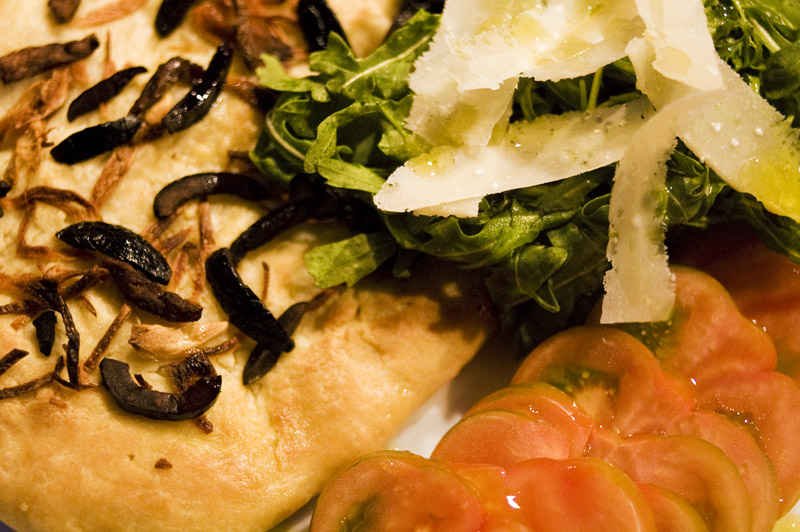 |
| Foccacia. Arugula with Parmesan. Heirloom tomatoes. That's it. |
Next most complicated: Arugula salad. Or roquette or rocket or whatever you call it in your neck of the woods. Toss that salad. (With salt.) Shave that smelly thing. (Parmesan cheese.) Serve drizzled with olive oil.
Next on the list: Sliced heirloom tomatoes. Sprinkle a tiny bit of salt. That's it. Oh yeah, serve drizzled with olive oil.
See a pattern there? Take simple ingredients, and give it a money shot with really fucking good olive oil.
Of course, one can't sit on the terrazza, sipping wine and nibbling antipasti all afternoon while the munchkins slurp spaghetti. When the sun goes down, we may feel the need for something hotter.
 |
| Pizza bianca with tuna, sweet onion, and lemon zest. Drizzled with olive oil. |
There are a gazillion varieties of pizza, obviously, but the key rule is to not overload it with toppings. When you're putting shit like white wine or sake into your dough, you kinda want to, you know, taste it.
You also want to taste your sauce. Especially if you've made it from scratch. And the best way to do that is to follow the tomato sauce recipe above for the spaghetti, and then pour that over sautéed onions and garlic and simmer. Done. You can also go a totally different way and spew white stuff all over your pizza dough.
For the first time, we made a pizza bianca (white pizza) - where instead of tomato sauce, we used crème fraîche. You can top a white pizza with anything, but just remember that if you use a seafood topping, the rule is: No cheese. There are a few exceptions here and there, but generally speaking, no one wants to snack on your tuna with a side of curdly cheese, mmkay?
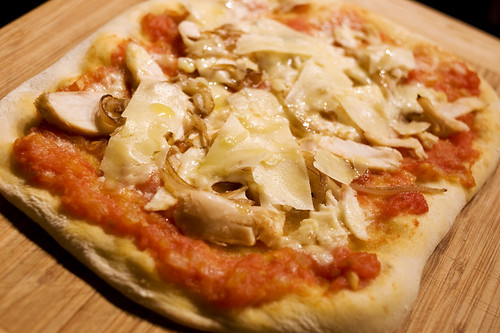 |
| Roast chicken with aged white cheddar and caramelized onions. |
Is it authentic Italian? Hell no. But making fresh bread and sauce to mop up and not waste what food you already have is totally in the paisan spirit.
A few nights ago, we had half a red bell pepper sitting around and getting ready to shrivel, so we sliced it up and threw it on a pie with mozzarella di buffula, caramelized onions and diced garlic, and it turned out to be the most cream-in-your-jeans delicious vegetarian pizza we've ever had.
Pizza dough also keeps really well: You can roll it up into balls and freeze it long term, or store it as a wad, in a sealed container in the fridge for a few days. So it's super easy to come home and throw a pie together after a long day of prostituting your ass out to whatever corporation you work for. In short, even a butt-whore can make good pizza. Providing s/he has a very hot oven.
In our fit of Italian experimentation and ridding ourselves of leftovers, we came to one of the most amazing dishes ever: Smoked herring carbonara.
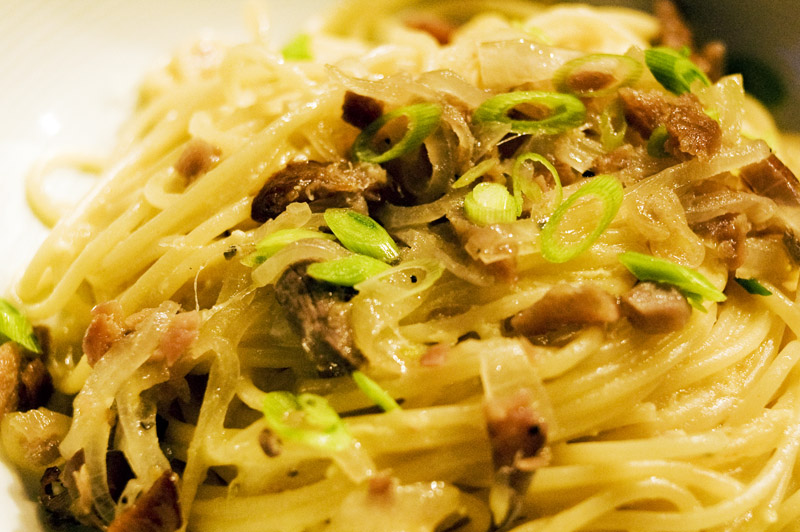 |
| Smoked herring. No cheese. Duh. |
The garnish is important, believe it or not. Personally, we've gotten into young garlic stem or ramps sliced up like chives or scallions. They taste more garlicky and have more crunch. But being that you can't always come by young garlic (or allium or ramps) any member of the green onion or chive family will do. Slightly greening up your carbonara that way will bring it to life and add more depth to the simple, delicious flavors already within. And that's what this cuisine is all about.
Come summertime, we'll send you an update how it goes in our Tuscan kitchen.
In the meantime, any Italians reading this, please feel free to correct any of our bullshit. We know that's the only way to con you into divulging your nonna's recipes.
05 May 2010
Cinco de Mayonnaise
Believe it or not, this is not another screed against the lack of decent Mexican food in Paris. There's enough about that in past entries. In fact, in light of the fact that it's Cinco de Mayo – wherein Mexico celebrates its ass-whooping of the French during the Battle of Puebla – it's not surprising that the French don't want any real Mexican food to compete with its cuisine. An upstart burrito might actually whomp a crèpe and turn the world of casual gastronomy on its ear, upsetting the order of monotony that keeps Parisians properly dour.
No, sir, I wasn't about to let the un-Mexicanness of anything around us on this most Mexican of marketing-fueled holidays get us down. I laughed off the Cinco de Mayo invites from not-even-Spanish-run Tapas bars flooding my inbox. I resisted the temptation to go to my local bar's tequila night.
Instead, we decided it was time for a little payback: It was time to represent la raza, and turn the tables, fucking with a fundamental of French cuisine. (Never mind that neither of us are Mexican, or Latino for that matter...)
Behold, Cinco de Mayonnaise. Whereupon the standard, classic French recipe for mayonnaise – egg yolk, acid (i.e. vinegar) and oil was bastardized, much the way they louse up Mexican food. I haven't had this much fun vigorously flailing my forearm since I first discovered "making mayonnaise" as an adolescent.
First up: Thai mayonnaise (based on Cock-brand fish sauce, sriracha chili, and peanut) and Japanese mayonnaise (based on rice vinegar and sugar for a Kewpie-style taste).
Rounding out the five: Aioli-styley (based on garlic and balsamic), Mexican (hot chili and lime), and in honor of Jon Stewart, the infamous Baconnaise (based on Dijon mustard and lovingly hand-minced lardon bits).
So to our hermanos y hermanas out there, this messing with French tradition is for you.
Of course, one does not simply tuck into mayonnaise. To quote Vincent Vega in Pulp Fiction, "they drown 'em in that shit." With 'em meaning: French fries.
After having read about how to make the best Belgian-style double-fried fries over at the French Culinary Institute's "Cooking Issues" blog (highly recommended reading if you're into food science), we decided to give it a go. It's a bit labor-intensive, but the results are way worthwhile. It'll be better once we have a dedicated high-volume deep fryer (soon, my pretties!) but these were awesome.
If you're curious, we skipped the optional pre-blanch step listed in the link above – first off because it's too time-consuming, and secondly because we think Jeffrey Steingarten is an asshat.
Of course, man cannot live on mayo-drenched fries alone. Alannah felt we should have something Mexican and fried up some corn tortillas into tostadas upon which we could have her crazy rich refried beans (featuring lard and lardons), salad, roasted chilis, and sour cream. Sure, it's a bit gringo, but then again, so are we!
No, sir, I wasn't about to let the un-Mexicanness of anything around us on this most Mexican of marketing-fueled holidays get us down. I laughed off the Cinco de Mayo invites from not-even-Spanish-run Tapas bars flooding my inbox. I resisted the temptation to go to my local bar's tequila night.
Instead, we decided it was time for a little payback: It was time to represent la raza, and turn the tables, fucking with a fundamental of French cuisine. (Never mind that neither of us are Mexican, or Latino for that matter...)
Behold, Cinco de Mayonnaise. Whereupon the standard, classic French recipe for mayonnaise – egg yolk, acid (i.e. vinegar) and oil was bastardized, much the way they louse up Mexican food. I haven't had this much fun vigorously flailing my forearm since I first discovered "making mayonnaise" as an adolescent.
 |
| Like yin and yang. Cuz they're Asian. Get it? |
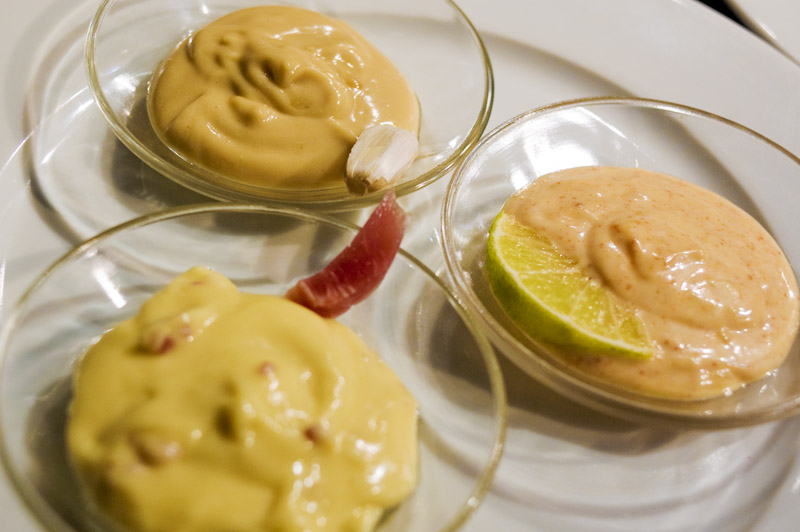 |
| Tres. Cuatro. Cinco. |
So to our hermanos y hermanas out there, this messing with French tradition is for you.
Of course, one does not simply tuck into mayonnaise. To quote Vincent Vega in Pulp Fiction, "they drown 'em in that shit." With 'em meaning: French fries.
 |
| Best homemade fries ever. (But we can do better!) |
If you're curious, we skipped the optional pre-blanch step listed in the link above – first off because it's too time-consuming, and secondly because we think Jeffrey Steingarten is an asshat.
Of course, man cannot live on mayo-drenched fries alone. Alannah felt we should have something Mexican and fried up some corn tortillas into tostadas upon which we could have her crazy rich refried beans (featuring lard and lardons), salad, roasted chilis, and sour cream. Sure, it's a bit gringo, but then again, so are we!
29 April 2010
A Sweet, Dark and Spicy Bastard
Despite our despisal of the despicable Tex-Mex places in Paris, we actually do love the bastard cuisine. It's actually one of the oldest American cuisines, the product of years of cultural exchange (or some might say subjugation or domination). We just don't like it when jerkwads try to pass it off as authentic Mexican.
Bastard food has its place, of course.
In fact, this last weekend I got out of bed a bit before Alannah and whipped together some migas, a Tex-Mex bastardization of chilaquiles: Fried stale tortillas scrambled with eggs, topped with chili or salsa, and served with a side of refried beans. (This isn't to be confused with the trendy Spanish version of migas, which is actually not the original, but a derivative of the Texan dish. Whoodathunkit?)
At any rate, this isn't about migas. This is about Alannah's insatiable craving after having snacked on my weekend treat. We had things to do and places to go, but she wanted churros. The trouble is, it was Saturday. And the only good churros we've found in Paris are sold at the Bastille marché on Sundays. (Any and all tips on how to get them on other days are welcome...) There are churro stands here and there, most notably near the crappy crèpe stands around the Grands Boulevards and other places foreigners go drinking, but good churros? Not a chance. The land of churros y chocolate may be just to the southwest, but this is a country resistant to imports.
Yes, churros are of Spanish origin. I always thought they were Mexican, because the guys selling them at amusement parks in California were Mexican. Or Filipino. But that's no way to determine food etymology, is it?
So anyway, Alannah decided to just do it: Make churros.
The batter's like a donut batter: Flour, eggs, milk, butter and sugar, only everything's integrated warm on the stove top... She made it and then passed it to me along with a huge pastry bag. So while she went to get all hot & steamy upstairs (in the shower), it was my duty to splash around with hot oil. Ain't marriage grand?
The only problem is that we don't have a huge star tip for the pastry bag. I tried using our biggest tip, squeezing gooey strips of churro batter into the hot oil, only to get what looked like donut-fries. Which I'm sure would do brisk business in middle America, but my gal wanted churros, dammit. Crisp on the outside, chewy-tender on the inside, and hot hot hot! These pathetic little pencil-dicked strips would not satisfy.
So my Middle Eastern blood kicked in and for the next batch, I squeezed the sac and flipped my wrist in a twirling motion, as though making zoolbia (in Persian, otherwise known as jalebi in Indian/Pakistani cooking). I filled the hot oil with little disks of tightly swirled dough, the end result a golden-brown rose of churro goodness.
By the time Alannah was dressed and back downstairs, I was finishing up a chocolate sauce to drizzle over the hot churros I'd already tossed in cinnamon sugar: Cream, a lot of cacao powder, sugar, cinammon, cayenne pepper, and a few drops of melting chocolate to thicken it.
So I give you, ladies and gentlemen, Chur-rose. Churros shaped like little roses. Hot, sweet, a little bit spicy, and – best of all – a perfectly acceptable bastardization of Latin food that didn't cost an arm and a leg.
Bastard food has its place, of course.
In fact, this last weekend I got out of bed a bit before Alannah and whipped together some migas, a Tex-Mex bastardization of chilaquiles: Fried stale tortillas scrambled with eggs, topped with chili or salsa, and served with a side of refried beans. (This isn't to be confused with the trendy Spanish version of migas, which is actually not the original, but a derivative of the Texan dish. Whoodathunkit?)
At any rate, this isn't about migas. This is about Alannah's insatiable craving after having snacked on my weekend treat. We had things to do and places to go, but she wanted churros. The trouble is, it was Saturday. And the only good churros we've found in Paris are sold at the Bastille marché on Sundays. (Any and all tips on how to get them on other days are welcome...) There are churro stands here and there, most notably near the crappy crèpe stands around the Grands Boulevards and other places foreigners go drinking, but good churros? Not a chance. The land of churros y chocolate may be just to the southwest, but this is a country resistant to imports.
Yes, churros are of Spanish origin. I always thought they were Mexican, because the guys selling them at amusement parks in California were Mexican. Or Filipino. But that's no way to determine food etymology, is it?
So anyway, Alannah decided to just do it: Make churros.
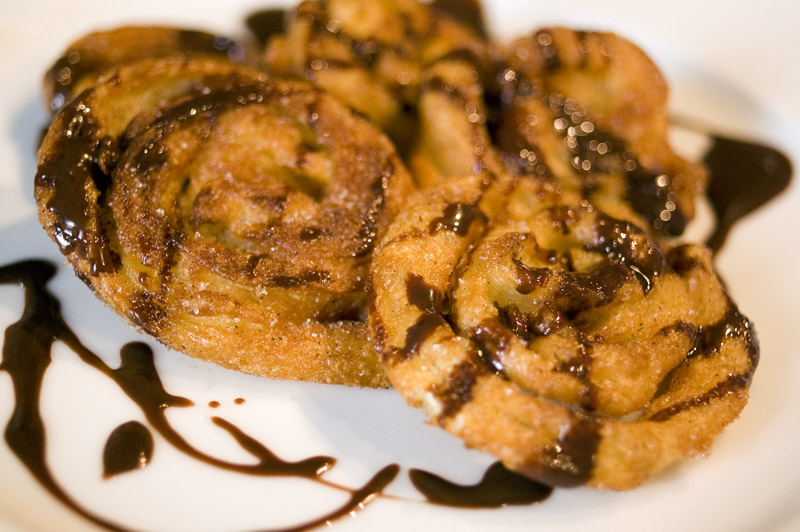 |
| These churros may look fancy, but they're actually a complete accident. Like your little brother. |
The batter's like a donut batter: Flour, eggs, milk, butter and sugar, only everything's integrated warm on the stove top... She made it and then passed it to me along with a huge pastry bag. So while she went to get all hot & steamy upstairs (in the shower), it was my duty to splash around with hot oil. Ain't marriage grand?
The only problem is that we don't have a huge star tip for the pastry bag. I tried using our biggest tip, squeezing gooey strips of churro batter into the hot oil, only to get what looked like donut-fries. Which I'm sure would do brisk business in middle America, but my gal wanted churros, dammit. Crisp on the outside, chewy-tender on the inside, and hot hot hot! These pathetic little pencil-dicked strips would not satisfy.
So my Middle Eastern blood kicked in and for the next batch, I squeezed the sac and flipped my wrist in a twirling motion, as though making zoolbia (in Persian, otherwise known as jalebi in Indian/Pakistani cooking). I filled the hot oil with little disks of tightly swirled dough, the end result a golden-brown rose of churro goodness.
By the time Alannah was dressed and back downstairs, I was finishing up a chocolate sauce to drizzle over the hot churros I'd already tossed in cinnamon sugar: Cream, a lot of cacao powder, sugar, cinammon, cayenne pepper, and a few drops of melting chocolate to thicken it.
So I give you, ladies and gentlemen, Chur-rose. Churros shaped like little roses. Hot, sweet, a little bit spicy, and – best of all – a perfectly acceptable bastardization of Latin food that didn't cost an arm and a leg.
27 April 2010
Take a Razor to Your Clam
Out of the blue the other day, I got the urge to snack on some clam. But not just any clam, razor clams. The idea came to me randomly. I thought, "I'd really like some razor clams, topped with a ginger-scallion sauce."
This isn't an entirely original craving. We'd had an amazing razor clam/scallion dish at the in-decline Mandarin Kitchen in Bayswater on our London Trip a couple of months before. But for some reason, I suddenly became singularly obsessed with making a David Chang-style ginger-scallion sauce and topping some long bivalves with it.
So we hit the markets in search of a shellfish that is usually used for bait here... Which means it's not easy to find.
We spotted a couple of small bundles of 'em at a fish stand in the Marché du Président Wilson in the posh 16th, but by the time we circled around to get them on our way out (it was a hot day, which doesn't mix with public transit and seafood) they were gone! Oh well, at least we'd picked up some beautiful, funky heirloom carrot varieties from Joël Thiebault, who has made a career out of raising gorgeous vegetables... and selling their "throwaway" parts to suckers at a premium. (Hey, Joël! Poor people have been eating turnip and beet greens forever!)
Luck turned up at Paris' tertiary Chinatown (in the 3rd arrondissement), where we were able to pick up a massive bundle of Ensis directus for about half the price of what we missed out on in the 16th. Checking 'em out, they were cold, fresh, alive, and – most importantly – plucked from the nearby North Sea, not shipped from halfway around the world as one might suspect in the Asian markets. Score!
Next up: Making a ginger-scallion sauce.
I've heard so many raves about David Chang's sauce as featured in the Momofuku cookbook, which I had picked up back when it came out at our favorite English-language bookstore in town. (Hint: It's not fucking WH Smith or Brentano's. Fuck them with a dusty old hardcover inserted diagonally.) But I'd never bothered to look at the recipe. In fact, I only got the book because it's good reading, and Alannah and I get giggles out of Chang's fuck-you attitude to the ruling food establishment.
The formula is dead simple: Ginger, scallions, oil, sherry vinegar, soy sauce, salt.
We decided, of course, to mess with the formula, because that's what we do. We replaced half the scallions with some gorgeous red ramps we found during our market adventures. Ramps are a bit more garlicky than scallions, and they also have a bit of an earthy flavor that we dig. Also, I made a Japanese-pride-fueled executive decision to substitute the sherry vinegar with a mix of rice vinegar and hon-mirin (Japanese cooking wine). Chop. Mince. Combine for 15 minutes. Done.
The sauce was poured over some cleaned, opened razor clams and placed under a super-hot broiler for just a couple of minutes...
While we were at it, I figured we should have some of the famous ginger-scallion noodles. Which entails all of pouring the same sauce over some hot, cheap ramen-type noodles.
Of course, having so much clam between the two of us, the feast continued for a couple more days. We'd made some deep-fried razor clams to have with our Mexican food, and we went on with our Asian theme to make a simple but gorgeous razor clam stir-fry.
There was also some more posh-16th-arrondissement market booty to be plundered, so we gently steamed some shimeji mushrooms, laid 'em on top of a bed of shredded steamed chicken... Topped off with more of the ginger-scallion-ramp sauce, of course.
In all, it made for a couple of days of delectable Asian eating, most of which is crazy simple to prepare. The only tough part was having to run around town to procure the various ingredients, but such is the nature of finding (or even making) good ethnic food in Paris.
This isn't an entirely original craving. We'd had an amazing razor clam/scallion dish at the in-decline Mandarin Kitchen in Bayswater on our London Trip a couple of months before. But for some reason, I suddenly became singularly obsessed with making a David Chang-style ginger-scallion sauce and topping some long bivalves with it.
 |
| Alive with pleasure. Squirming, pulsating pleasure. |
We spotted a couple of small bundles of 'em at a fish stand in the Marché du Président Wilson in the posh 16th, but by the time we circled around to get them on our way out (it was a hot day, which doesn't mix with public transit and seafood) they were gone! Oh well, at least we'd picked up some beautiful, funky heirloom carrot varieties from Joël Thiebault, who has made a career out of raising gorgeous vegetables... and selling their "throwaway" parts to suckers at a premium. (Hey, Joël! Poor people have been eating turnip and beet greens forever!)
Luck turned up at Paris' tertiary Chinatown (in the 3rd arrondissement), where we were able to pick up a massive bundle of Ensis directus for about half the price of what we missed out on in the 16th. Checking 'em out, they were cold, fresh, alive, and – most importantly – plucked from the nearby North Sea, not shipped from halfway around the world as one might suspect in the Asian markets. Score!
Next up: Making a ginger-scallion sauce.
I've heard so many raves about David Chang's sauce as featured in the Momofuku cookbook, which I had picked up back when it came out at our favorite English-language bookstore in town. (Hint: It's not fucking WH Smith or Brentano's. Fuck them with a dusty old hardcover inserted diagonally.) But I'd never bothered to look at the recipe. In fact, I only got the book because it's good reading, and Alannah and I get giggles out of Chang's fuck-you attitude to the ruling food establishment.
The formula is dead simple: Ginger, scallions, oil, sherry vinegar, soy sauce, salt.
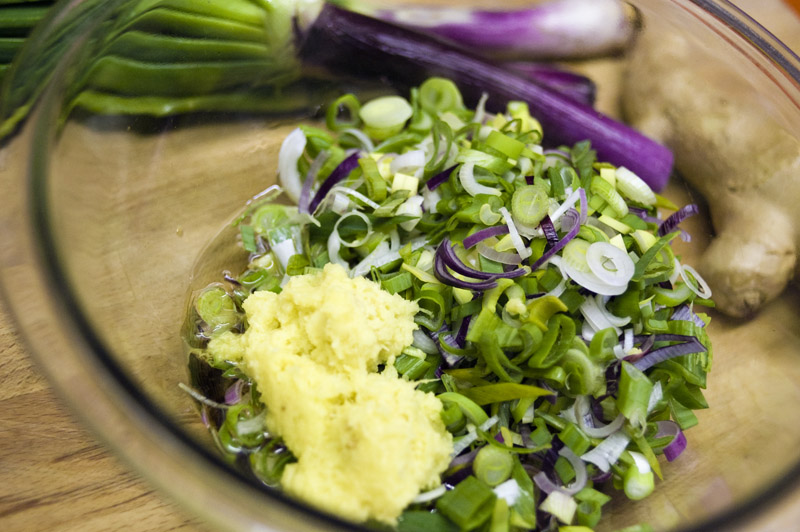 |
| Ginger-Scallion sauce.. the Ramped up version. Har har. |
The sauce was poured over some cleaned, opened razor clams and placed under a super-hot broiler for just a couple of minutes...
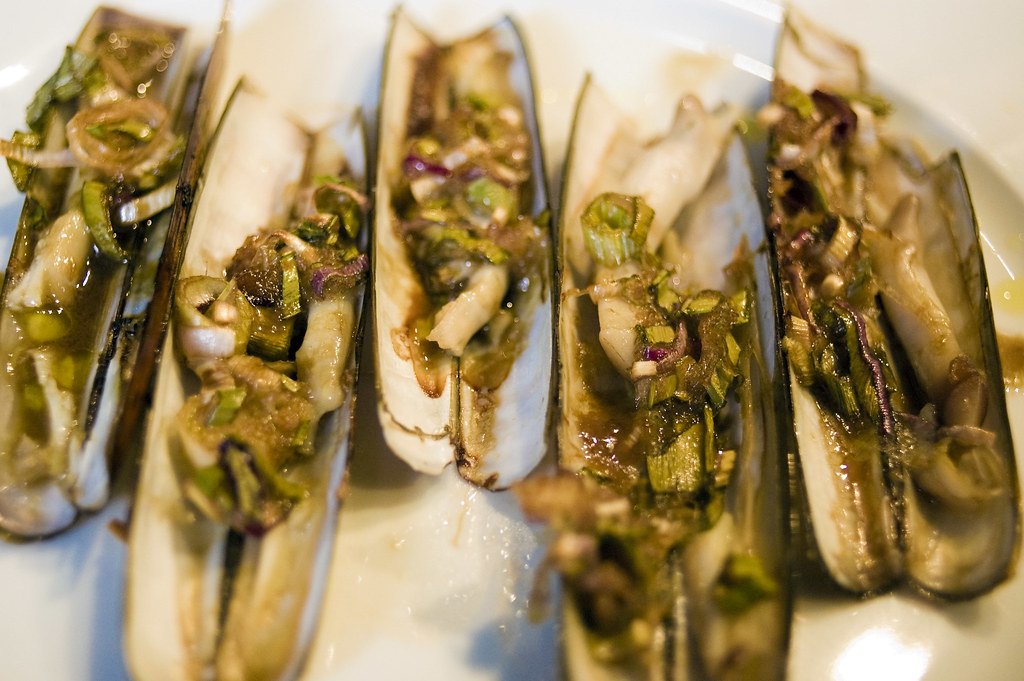 |
| Lap up the juices on these hot, vertical clams |
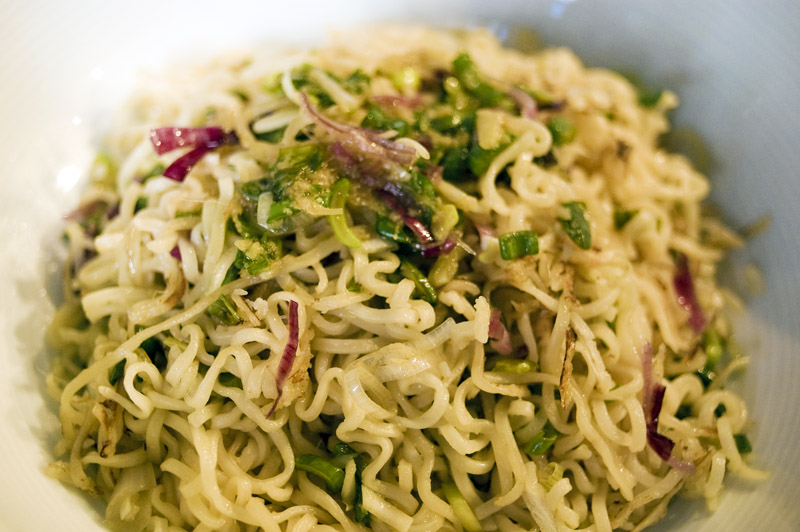 |
| Slurp this |
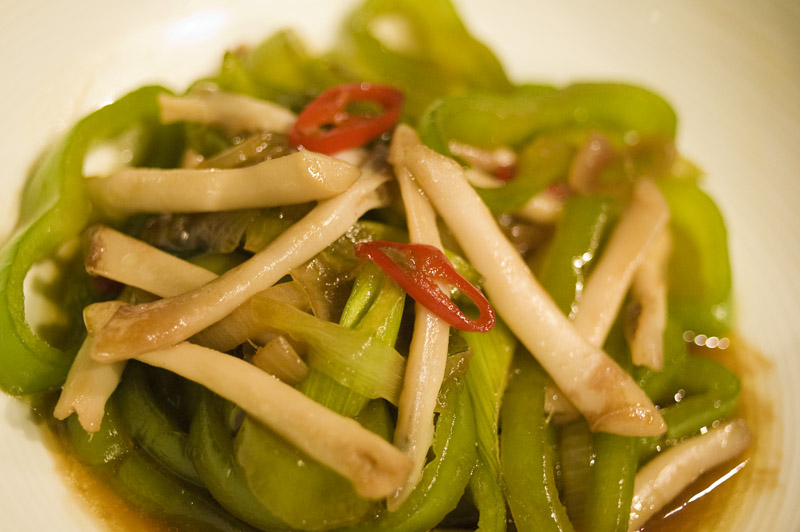 |
| It's as if scallops and lobster mated and put tubular babies on top of veggies |
There was also some more posh-16th-arrondissement market booty to be plundered, so we gently steamed some shimeji mushrooms, laid 'em on top of a bed of shredded steamed chicken... Topped off with more of the ginger-scallion-ramp sauce, of course.
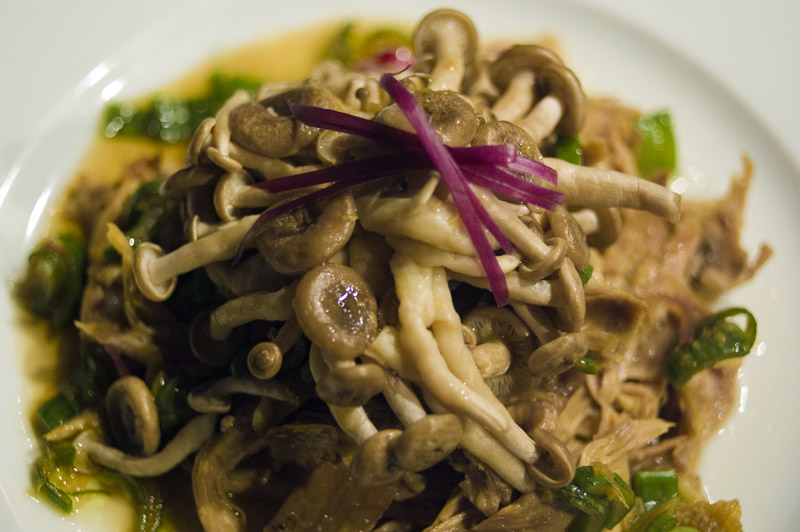 |
| Mmmm... Shroomy |
20 April 2010
Rant: Mexican't
This is a bitch & moan post with a cause. Read on for the goods.
Last night we ripped on the state of casual American food in Paris, and suggested how easy it is to make far superior burgers and pancakes than what you can find in the slew of "American Diner" themed hovels throughout the town.
Unfortunately, this situation extends to all sorts of ethnic food in France. Despite being a beautifully multicultural place, what few plausible ethnic restaurants you can find are often "dumbed down" for the local palate. This makes sense in a reputedly risk-averse society, but at the same time makes no sense in the country that coined the term "vive la différence."
Nowhere is this more evident than in the realm of Mexican cuisine, the majority of which is represented by ground beef (!) burritos and insipid fajitas and so-called tacos in factory-made flour tortillas. What the fuck is going on here? I'll tell you what: The virulent disease known as Tex-Mex, which much like anything from Texas is as irritating and unwanted as a case of syphilis. Only harder to get rid of. The Tex-Mex trend in Paris has insured that even the most well-meaning of real, Mexican-run restaurants has to sell slushy margaritas and faux burritos to stay in business.
Despite the hardship it presents, the only decent Mexican food in town comes at our own hands. Unlike the aforementioned burgers and pancakes, though, it's not particularly easy. Some of it, like a proper molé sauce, is downright labor-intensive. But if a guera and a chino gordo (I'm not Chinese, but that's what they call me south of the border) can find the ingredients and take the time to make the real deal, why can't the restaurateurs?
As I write this, I'm eating leftover tamales that Alannah made last night, and even nuked in a plastic tupperware container it's better than anything you can get at the local Indiana Café or Mexi&Co. Yes, the corn husks and masa are hard to source, but they exist.
Admittedly, the razor clams you see above aren't part of the authentic Mexican oeuvre. (Machas, as they're called in Spanish, seem to be limited to Chilean cuisine.) But even the most well-regarded Latin-inspired restaurants here won't dare depart from the established formula and dust some mariscos with masa crocante. They fail to educate or challenge their clientele, and instead bow to their expectations.
Even the faux Mexican isn't creative. In about three seconds, Alannah whipped up an accompanying dessert for last night's dinner. Sliced fresh mangos with a dipping sauce of chocolate, cream, and spices. While not authentically Latin, it at least played within the flavors of the cuisine, while offering something besides the bastardized mediocrity Parisian diners are accustomed to.
The flavors were so fantastic, that we're going to develop a cocktail based on this improvised dessert to serve with Mexican food next time we entertain. Screw your slushy margarita.
The Good Cause Part
Luckily, there is one publicly accessible place where the status quo is being challenged. At La Rotisserie de Sainte-Marthe in the 10th arrondissement, they have a mission: To prevent the gentrification of their part of the quartier, and to preserve the rich ethnic identity of the many small immigrant groups within. By day they're a restaurant serving 5-euro meals to the locals. By night, they allow member non-profit organizations to take the restaurant over and share full meals (price cap: 10 euros) with the community.
Once a month, the arts collective Sonidero Tochtli hosts a Mexican dinner. This thursday will feature tacos de barbacoa, nopales (cactus) salad and a convivial community atmosphere unmatched by any other restaurant in town. (The €1.50 beer/wine might have something to do with it.)
It's not fancy. It's elbow-to-elbow seating. But the food is fantastic, and it's all done for good reason. We'll see you there.
Last night we ripped on the state of casual American food in Paris, and suggested how easy it is to make far superior burgers and pancakes than what you can find in the slew of "American Diner" themed hovels throughout the town.
 |
| Tamales with chicken and chili filling, masa-crusted razor clams, fresh guacamole... At nuestra casa. |
Nowhere is this more evident than in the realm of Mexican cuisine, the majority of which is represented by ground beef (!) burritos and insipid fajitas and so-called tacos in factory-made flour tortillas. What the fuck is going on here? I'll tell you what: The virulent disease known as Tex-Mex, which much like anything from Texas is as irritating and unwanted as a case of syphilis. Only harder to get rid of. The Tex-Mex trend in Paris has insured that even the most well-meaning of real, Mexican-run restaurants has to sell slushy margaritas and faux burritos to stay in business.
Despite the hardship it presents, the only decent Mexican food in town comes at our own hands. Unlike the aforementioned burgers and pancakes, though, it's not particularly easy. Some of it, like a proper molé sauce, is downright labor-intensive. But if a guera and a chino gordo (I'm not Chinese, but that's what they call me south of the border) can find the ingredients and take the time to make the real deal, why can't the restaurateurs?
As I write this, I'm eating leftover tamales that Alannah made last night, and even nuked in a plastic tupperware container it's better than anything you can get at the local Indiana Café or Mexi&Co. Yes, the corn husks and masa are hard to source, but they exist.
Admittedly, the razor clams you see above aren't part of the authentic Mexican oeuvre. (Machas, as they're called in Spanish, seem to be limited to Chilean cuisine.) But even the most well-regarded Latin-inspired restaurants here won't dare depart from the established formula and dust some mariscos with masa crocante. They fail to educate or challenge their clientele, and instead bow to their expectations.
Even the faux Mexican isn't creative. In about three seconds, Alannah whipped up an accompanying dessert for last night's dinner. Sliced fresh mangos with a dipping sauce of chocolate, cream, and spices. While not authentically Latin, it at least played within the flavors of the cuisine, while offering something besides the bastardized mediocrity Parisian diners are accustomed to.
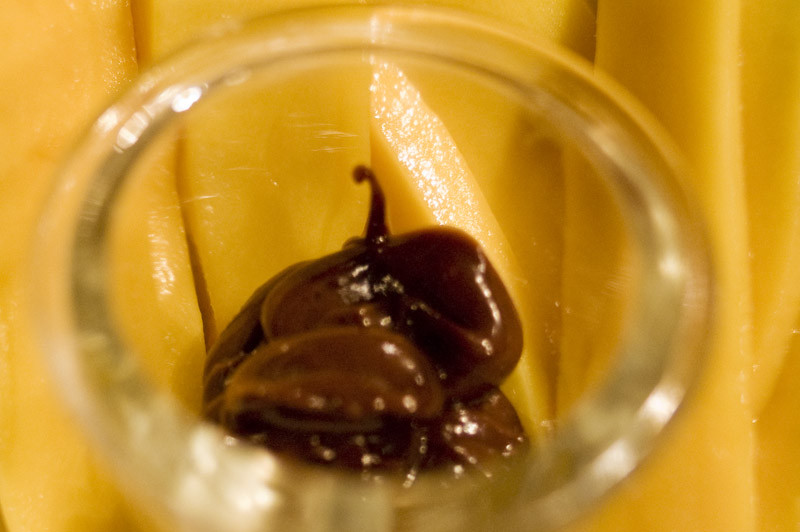 |
| Mango y chocolate... Simple but effective. |
The Good Cause Part
Luckily, there is one publicly accessible place where the status quo is being challenged. At La Rotisserie de Sainte-Marthe in the 10th arrondissement, they have a mission: To prevent the gentrification of their part of the quartier, and to preserve the rich ethnic identity of the many small immigrant groups within. By day they're a restaurant serving 5-euro meals to the locals. By night, they allow member non-profit organizations to take the restaurant over and share full meals (price cap: 10 euros) with the community.
Once a month, the arts collective Sonidero Tochtli hosts a Mexican dinner. This thursday will feature tacos de barbacoa, nopales (cactus) salad and a convivial community atmosphere unmatched by any other restaurant in town. (The €1.50 beer/wine might have something to do with it.)
It's not fancy. It's elbow-to-elbow seating. But the food is fantastic, and it's all done for good reason. We'll see you there.
Subscribe to:
Comments (Atom)

